



Connected FALL/WINTER 2023 CHELSEA — DEXTER — GRASS LAKE — MANCHESTER — STOCKBRIDGE IN THIS ISSUE: Stories of how Eating Better is the easy choice in the 5 Healthy
NON PROFIT ORG US POSTAGE PAID PERMIT 38 FULTON, MO
Towns.
The Sustainable Modern Homestead
The Sustainable Modern Homestead
The Sustainable Modern Homestead started with a set of fundamental ideas; an energy-efficient, earth-friendly home that melds interior and exterior, inviting open space into the home environment without sacrificing privacy, and that engages the surrounding landscape for its beauty, as well as its natural warmth and cooling potential.
The Sustainable Modern Homestead started with a set of fundamental ideas; an energy-efficient, earth-friendly home that melds interior and exterior, inviting open space into the home environment without sacrificing privacy, and that engages the surrounding landscape for its beauty, as well as its natural warmth and cooling potential.
The Sustainable Modern Homestead represents a robust collaboration between Giraffe’s skilled designers, the homeowners, and our trusted construction teams. Through a series of early schematic massing and plan review sessions, Giraffe designers and the homeowners were able to develop a spatial arrangement that was uniquely suited to their family, while embracing a series of sustainable features they are passionate about. Deep roof overhangs and a careful arrangement of south facing windows create passive solar heating potential. A strong, central east-west axis connects a series of distinct but connected public and private spaces. Alignment of windows and doors on the north and south facades create a visual harmony on the exterior as well as a potential for cross ventilation and circulation in the home.
The Sustainable Modern Homestead represents a robust collaboration between Giraffe’s skilled designers, the homeowners, and our trusted construction teams. Through a series of early schematic massing and plan review sessions, Giraffe designers and the homeowners were able to develop a spatial arrangement that was uniquely suited to their family, while embracing a series of sustainable features they are passionate about. Deep roof overhangs and a careful arrangement of south facing windows create passive solar heating potential. A strong, central east-west axis connects a series of distinct but connected public and private spaces. Alignment of windows and doors on the north and south facades create a visual harmony on the exterior as well as a potential for cross ventilation and circulation in the home.
New, sustainable materials Giraffe integrated into the architecture of the Sustainable Modern Homestead include 5.5” T-stud framing, Havelock Sheep’s Wool insulation, ZIP R6 insulated sheathing, a standing seam metal roof made from recycled materials, Arbor Woods thermally modified cladding and Vesta Steel siding.
New, sustainable materials Giraffe integrated into the architecture of the Sustainable Modern Homestead include 5.5” T-stud framing, Havelock Sheep’s Wool insulation, ZIP R6 insulated sheathing, a standing seam metal roof made from recycled materials, Arbor Woods thermally modified cladding and Vesta Steel siding.




giraffe
Inside the home, Giraffe stewarded the owner’s vision installing radiant heating and high thermal mass concrete floors throughout the home, a Unico high speed forced air system and a whole house HRV (heat recovery ventilator).
Inside the home, Giraffe stewarded the owner’s vision installing radiant heating and high thermal mass concrete floors throughout the home, a Unico high speed forced air system and a whole house HRV (heat recovery ventilator).
The Sustainable Modern Homestead combines thoughtful, clean designs with sustainable, progressive-thinking construction methods and systems. Giraffe’s and the homeowners’ goal is to make this type of building practice a standard for the homes we build today and in the years to come.
The Sustainable Modern Homestead combines thoughtful, clean designs with sustainable, progressive-thinking construction methods and systems. Giraffe’s and the homeowners’ goal is to make this type of building practice a standard for the homes we build today and in the years to come.
Follow us on Instagram @giraffedesignbuild to see our in-depth build process, and the details for our upcoming Giraffe Design Build in-studio presentation on building your own sustainable home.
Follow us on Instagram @giraffedesignbuild to see our in-depth build process, and the details for our upcoming Giraffe Design Build in-studio presentation on building your own sustainable home.
2
info@giraffedesignbuild.com 734.562.2125 giraffedesignbuild.com
info@giraffedesignbuild.com 734.562.2125 giraffedesignbuild.com
What does a hand specialist do?
Q&A with Ryan Beekman, M.D., hand surgeon and pediatric hand specialist at the new Henry Ford Medical Center – Chelsea

Our hands are critical for performing all daily activities. This is why many people get nervous when they develop a condition or experience an injury that affects their hands. Fortunately, with proper treatment most conditions will not lead to a significant loss of function in your hand—or your wrist, forearm or elbow. Hand specialists treat all of these areas, and we work on everything, including bones, nerves, tendons and blood vessels. If there is a problem in your arm we are here to help.
Do you treat certain ages?
We treat people across the lifespan, from birth to seniors.
What types of conditions do you see?
We offer care for a wide range of conditions and injuries, everything from arthritis, carpal tunnel syndrome, wrist tendonitis and trigger finger, to fractures, trauma and lacerations. For each patient, our focus is on quality of life and maintaining function.
When do kids tend to get injured?
Trauma can happen at any age, but we often see it starting around age 3 when kids become more mobile and active. This can include lacerations, fingers getting closed in a door as well as wrist and elbow injuries from the playground. Kids can also be born with hand differences or develop them at a young age, such as congenital trigger thumb.

What about sports-related injuries?
Certain sports can lead to more injuries. For example, football season is getting ready to start, and in contact sports like this we tend to see a lot of wrist and forearm fractures as well as jammed fingers, fractures and thumb injuries.
How are hand conditions diagnosed?
Patients often come to us after a referral from their primary care physician or an ER visit. However, people can also call us directly for a consultation. For many conditions, we take an X-ray and can perform these onsite at our Chelsea medical center—as well as do any lab work such as blood tests. When additional advanced imaging such as an MRI or CT is needed, we can help coordinate these at one of our other facilities.
What treatments are available?
Depending on the condition or injury and its severity, we may offer options such as medications, therapy, a splint or cast, or if necessary surgical intervention. When urgent treatment is needed, we can see people the same day or next day. We also have certified hand therapists onsite, as well as other advanced practice providers who are focused specifically on hand treatment and recovery.
visit
33 333
SPONSORED
CONTENT
To request a consultation with one of our local experts at Henry Ford Medical Center – Chelsea, call 517.205.2165. To learn
hand conditions
treatment,
henryford.com/hand
more about
and
Welcome to Connected Fall/Winter 2023
As the leaves start to change and we’re enjoying the best of our favorite apple orchards and corn mazes, we also get to turn out some of our favorite holiday recipes as we gather with those we love. Often those recipes connect generations, as we share with our own kids the familiar tastes and smells that our parents and grandparents shared with us.
This edition of Connected celebrates those stories of connection, and the stories of other individuals and community-based organizations that inspire, educate, and empower us to Eat Better.
From field to fork, these important community partnerships strengthen the foundations of our 5 Healthy Towns by making investments in activities and initiatives that help each of us Eat Better. Farmers’ markets foster a connection between growers and the community while they bloom with seasonal bounty, creating vibrant hubs for fresh, locally sourced produce.

Creating a culture of health also requires nurturing the roots of our communities. By investing in nutritional education programs like
Dexter’s Farm to School program, or delivering workshops, seminars, and cooking classes; the Foundation equips kids and families with the tools to make informed decisions about
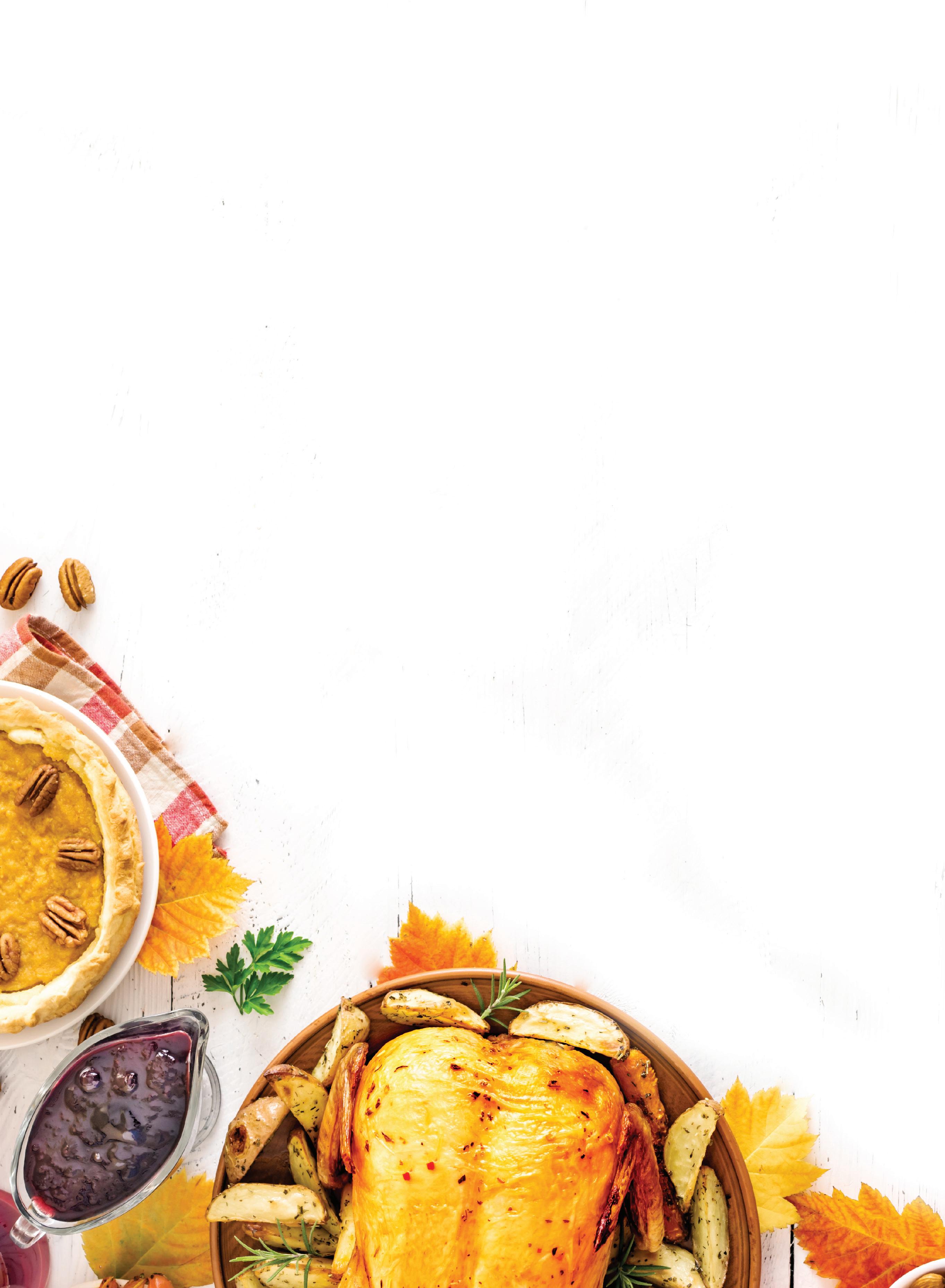
While we celebrate the assets that make our communities the wonderful places they are to live, we also know that many of our friends and neighbors are often faced with difficult decisions when it comes to food. We shine a spotlight on organizations such as Food Gatherers and other hunger relief agencies that stand as pillars of support for our neighbors grappling with food insecurity. Partnerships with organizations like Chelsea Hospital, Stockbridge Community Outreach and Manchester Resource Center have allowed mobile markets, community pantries, and innovative distribution networks to bridge the gap between food availability and food security.
As you read through this issue, may you be inspired to make choices that honor your ancestors, and your well-being this holiday season! More than that, we encourage you to become more connected to some of the initiatives and activities in the stories we share with you. Volunteering is one way you can directly support others around the holidays, while also enjoying the nourishment of giving back to your community.
In good health,

Steve 4

55
Written by Rachel Walsh, Zingermans Cornman Farms


Written by Lauren Grossman, Food Gatherers


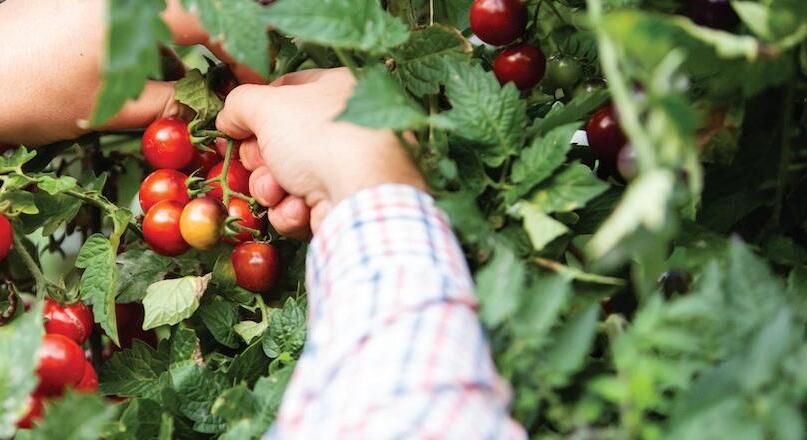
Written by Jennifer Fairfield, The Garden Mill in Chelsea
Written by Natalie Schwartz, PhD Timber Creek Counseling
Written by Lori Kintz 47
Written by Lori Kintz
Written by Sheila Gillman
Written by Matt Pegouskie
Written by Lori Kintz
6 CONTENTS FALL/WINTER 2023 Creating a food secure future. 46 IN EVERY ISSUE CAUGHT IN THE ACT - 48 RECIPES - 56 LOCAL RESOURCES - 60 Our 27 acre farm is bustling in the fall – Come Visit Us! Ensuring everyone in our community has access to the food they need to thrive.
Food, 12 – COMMUNITY SUPPORTED AGRICULTURE Written by Lori Kintz 14 – THE HORNING FAMILY FARM Written by Ray Berg 16 – EATING HEALTHY ON A BUDGET Written by Sophia Speroff 18 – BOOKS AND PODCASTS FOR YOU! Written by Amy Heydlauff 20 – RETHINK THE MORNING COFFEE AND DONUTS Written by Lori Kintz 22 – WEIGH THE BENEFITS Written by Lori Kintz 24 – IT’S EASY TO EAT BETTER IN THE 5 HEALTHY TOWNS Written by Lori Kintz 26 – BREAKING BREAD Written by Lori Kintz 28 – DRY JANUARY 2024 – A MONTH OF SOBRIETY AND WELLNESS Written by Alex Duranczyk 32 – FILLING THE GROCERY GAP – A CASE STUDY FOR SUCCESS Written by Matt Pegouskie 34 – IT’S ORGANIC! Written by Lori Kintz 36 – SEWING SEEDS OF COMMUNITY TOGETHERNESS Written by Marianne Wendt 39 – COOKING HACKS
Great
42 – HEALING GARDENS
44 – DOES YOUR LIFESTYLE NEED A NUTRITION LABEL REVIEW?
– KEEP YOUR MOUTH HEALTHY
Written by Sophia Speroff 45
– DO YOU KNOW WHAT HUNGER LOOKS LIKE?
50 – AN APPLE A DAY!
53 – PRESERVE LOW
JAMS
JELLIES
AND NO-SUGAR
&
54 – AVOCADOS – NUTRITIOUS, DELICIOUS, VERSATILE Michigan State
Extension
Michigan State University Extension
University
future farmers of america in stockbridge
10 8
love.
Written by Bob Richards, Stockbridge Community Schools
prepared with
how to make healthier dietary changes
40 putting your garden to bed
38
5HF Wellness Centers
Adult Learners Institute

Brio Living Services
Chelsea Community Foundation

Chelsea District Library
Chelsea Education Foundation
Chelsea Hospital
Chelsea State Bank
Cornman Farms - Zingermans
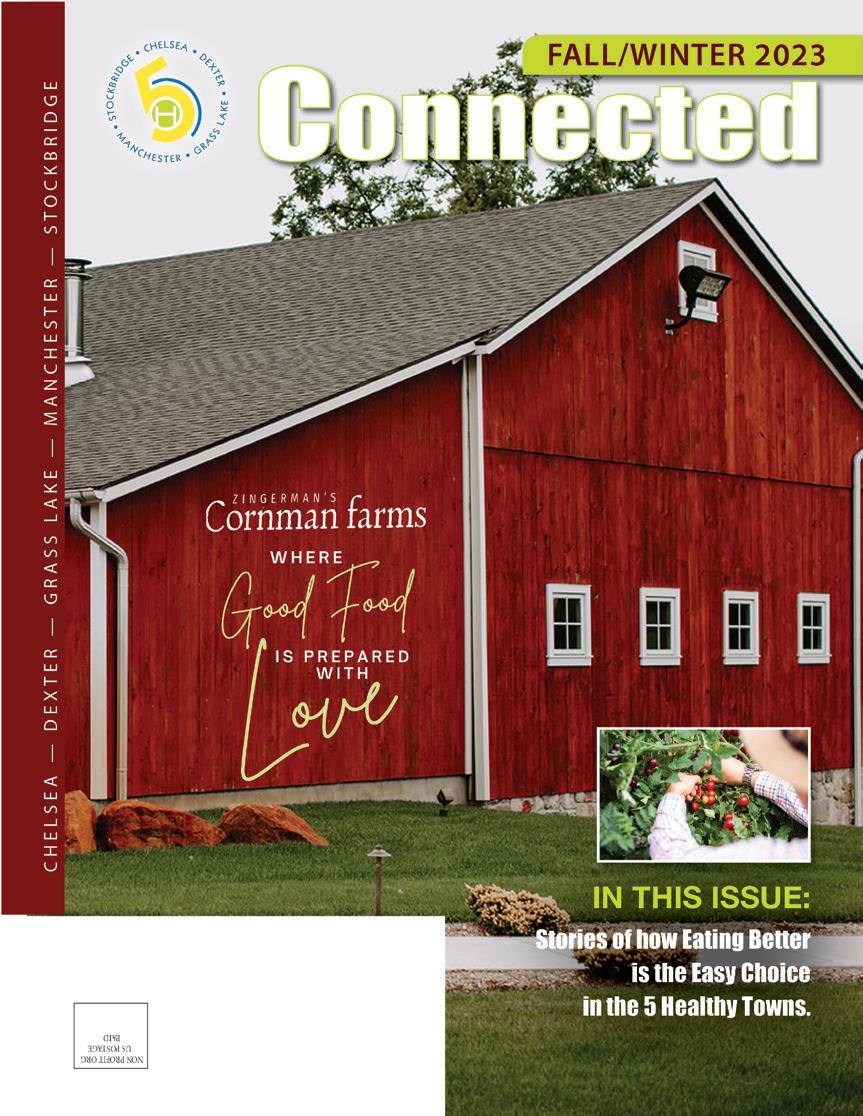
Dexter Community Schools
Eder & Diver Farm Bureau Insurance
Educational Foundation of Dexter
Esquire Interiors
Giraffe Design Build
Grass Lake Senior Center
H&R Block
Heydlauff’s Appliances
Henry Ford Health
Horizon Kitchen & Bath
Housing Bureau for Seniors
Huron-Clinton Metroparks
Huron Waterloo Pathways Initiative
Jiffy Mix
Klink & Associates
Manchester School District
Mental Health Awareness and Training
Orthopaedic Rehab Specialists, P.C.
Palmer Auto Service
Purple Rose Theatre Company
Rankin Audiology
Silver Maples of Chelsea
The Copper Nail
Washtenaw County Public Safety and Mental Health Preservation Millage
Washtenaw County Parks and Recreation
WAVE
7 77 A special thank you to our ADVERTISERS 5 Healthy Towns Foundation makes every effort to provide accurate information in advertising and editorial content, however, does not make any claims as to accuracy of information provided by advertisers or editorial contributors and accepts no responsibility or liability for inaccurate information. For information on how to advertise, please contact 5 Healthy Towns Foundation at (734) 433-4599 7
CONNECT WITH THE COMMUNITY! If you would like to advertise in the next issue of Connected magazine call or email Lori Kintz (734) 433-4599 lori@5healthytowns.org Reach 30,000 of your closest neighbors! Connected is published by and is the property of the 5 Healthy Towns Foundation
GOOD FOOD PREPARED
Cornman Farms is an awardwinning, chef-led event space, wedding venue and working farm in Dexter, Michigan. The 27-acre farm and venues were restored from their 1834 foundations with the most discerning guests in mind


The campus is made up of a beautiful exhibition kitchen, chef’s garden, a classic farmhouse and four-season barn. We believe nothing brings a family, a team, or a community together like good food, prepared with love. It is the heart of what we do, and we couldn’t imagine a better way of being a part of a community than by sharing a piece of our heart.

8
8
Welcome to Zingerman’s Cornman Farms. We would love to tell you a little bit more about ourselves and how we take part in our healthy community.
While weddings and private events are our bread & butter, we are incredibly mindful of our role in the larger community. In between hosting events, we focus on pop ups that offer educational opportunities to the community at large.

Earlier this summer we held our first series of Camp for a Cause! This three-day immersive experience for 9–12year-olds was designed to bring awareness and resources to local non-profits while teaching kids about vegetable gardening and cooking in a hands-on environment.
Campers were sent home with recipes, skills and even fresh herbs so they could continue learning at home.

They spent time with representatives from Food Gatherers, the food bank and food rescue program serving Washtenaw County (see page 28), learning about food insecurity and the impact the food they prepared throughout the week would have for local families.
Do you know a child that might be interested in participating next summer? Please email us at cornmanevents@zingermans.com and we would be delighted to sign you up for our e-newsletter.
Fall is such an incredible time in Southeastern Michigan. The weather turns crisp, the leaves change and there is an abundance of hearty fall vegetables and fruits growing all around us.
As you might imagine, it is quite a popular time for celebrations, and the farm is bustling. However, just around the corner is one of our favorite events of the year: Thanksgiving To-Go!
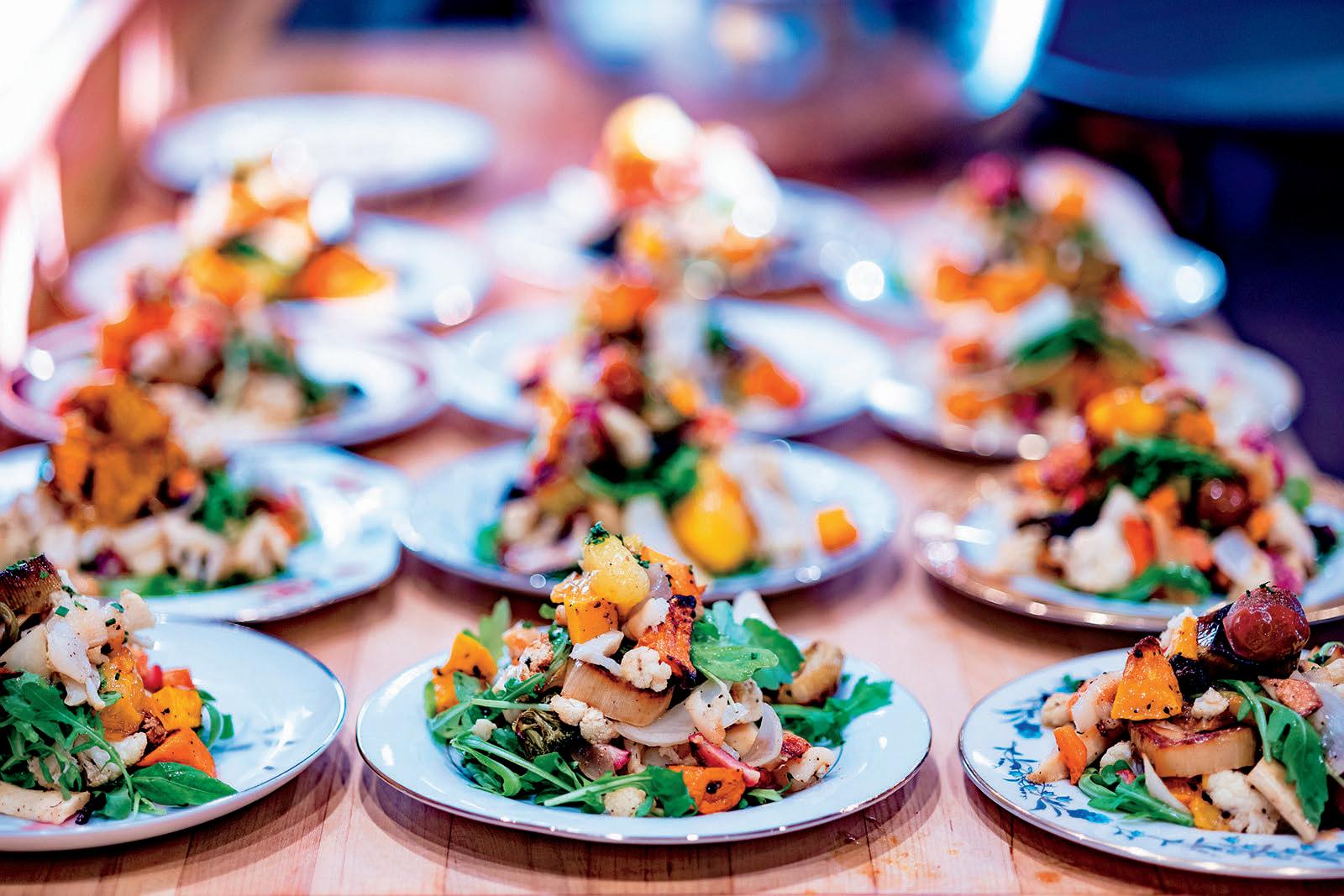
Every November we bring together as many local products as possible to provide a hearty and delicious Thanksgiving meal. Nothing tastes quite as good as squash and kale harvested from our gardens and turkey that was raised right down the road. All products are sold a la carte, so we can be an addition to some of your favorite family recipes or provide the whole meal. All you have to do is think about spending time with those you love.
To learn more, please visit zingermanscornmanfarms.com/ culinary/thanksgiving-to-go/.
9
Zingerman’s Cornman Farms — 8540 Island Lake Rd Dexter, MI 48130
FARMERS OF AMERICA FARMERS OF AMERICA Learning to Do, Doing to Learn
One of the biggest realizations coming out of the 2020 COVID shutdowns was the amount of food insecurity in our local community and state. A person is food insecure when they lack regular access to enough safe and nutritious food for normal growth and development and an active and healthy life. During the COVID shutdown and its aftermath our students, many for the first time, became aware of hunger in their own communities. Because of this, many of the projects in our class shifted from robotics to food production.
Written by Bob Richards, Stockbridge Agriculture Teacher
One of the first things we did was to obtain district permission to begin rehabbing our old apple orchard. The school’s apple orchard was originally planted in the mid-1970’s as the high school was being built. The orchard was maintained by our then thriving FFA Chapter and Agriculture Program. The apple orchard had fallen into disrepair since the closing of our FFA Chapter and Agriculture Program in 1988. During COVID the apple orchard provided a location for outdoor education and relief from masking.The students worked to clear brush, trim trees and mow. While the apple orchard is far from done, it provides students with a place to apply classroom knowledge while learning valuable life skills.
During this time students also constructed ten 4’x10” raised planter beds outside our classroom. Students have planted cucumbers, onions, tomatoes and peppers along with herbs and flowers. The students have also learned how to grow crops using hydroponic and aquaponics systems. These systems have mainly been used to grow salad greens such as lettuce, kale, swiss chard, bok choy and mustard greens. The edible plants are then harvested by the students and used in the school cafeteria’s salad bar.
With an increased interest in growing food came an increased interest in agriculture. During the 2021-2022 school year, Stockbridge Community Schools rechartered their FFA Chapter. In the Fall of 2021 Stockbridge High School offered its first Agriculture class since 1988. In the Fall of 2022, the newly chartered FFA Chapter and its associated agriculture class entered the Michigan FFA Broiler Project Program and raised a flock of 25 broiler chickens. The class also started a laying flock of 14 chickens. The students sell eggs as part of class and donate eggs to Stockbridge Community Outreach. This summer students have donated 10 dozen eggs to Community Outreach and are planning to increase donations as the program continues to grow.



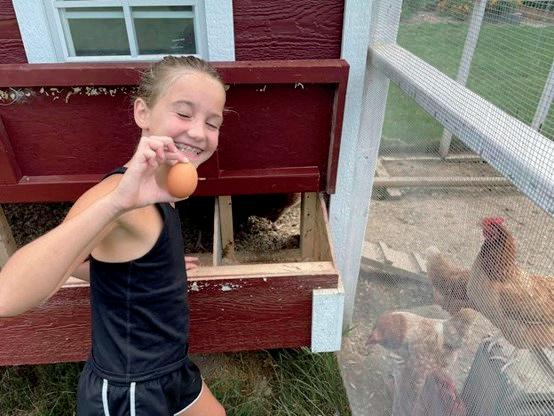

Soon, the Stockbridge FFA Chapter is expected to more than double in size. Students are excited to learn more about where their food comes from and how it is produced. As the world’s population is expected to increase to 10 billion people by 2050, we need a new generation that can sustainably feed an additional 2 billion people with the same amount of land.
Our students appear to be ready for the challenge to learn new and more efficient methods of food production.
For more information about the Stockbridge FFA, contact Bob Richards at richardsr@panthernet.net or follow us on Facebook at: https://www.facebook.com/Stockbridge.FFA.MI
10
STOCKBRIDGE FUTURE STOCKBRIDGE FUTURE
10

11
Joining a CSA will make you feel good about supporting the local farming economy and building a relationship with those who grow your food in a healthy way.
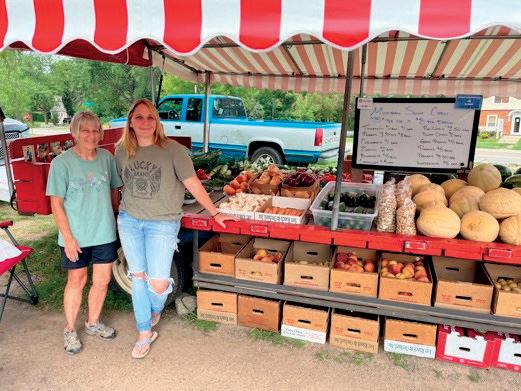
Community Supported Agriculture
Many farms across Michigan offer CSA memberships. To find the perfect CSA fit for you, visit localdifference.org/csa and explore the farms in your area. But don’t wait too long to sign up, shares often sell out quickly!
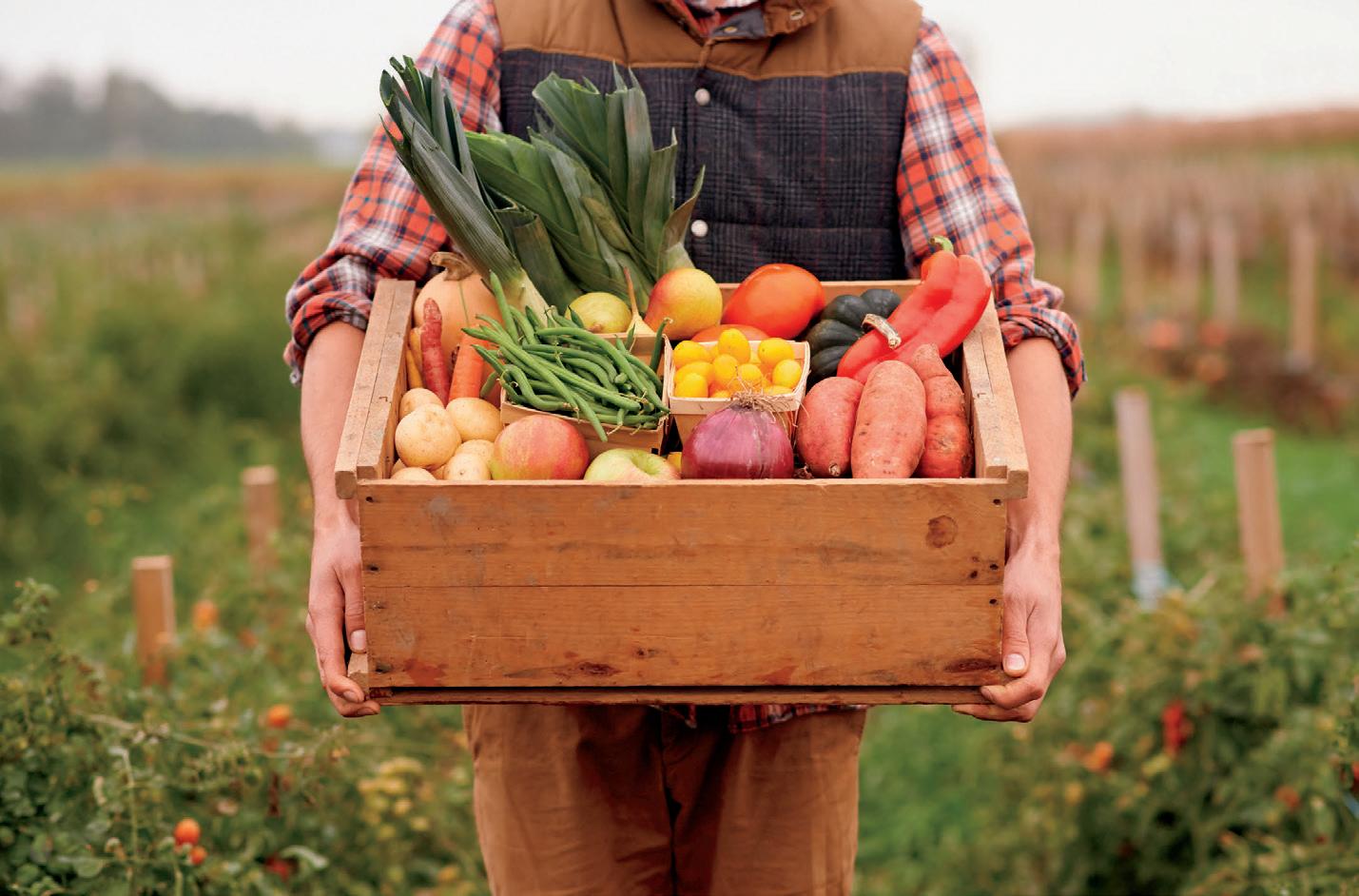
HOW THE FOOD
on Your Table
CAN BRING YOU PEACE OF MIND
Written by 5 Healthy Towns Foundation staff
Your average food item in the grocery store travels 1300 miles from the farm to your shopping cart. But knowing where your food comes from can be a huge step to supporting sustainable local agriculture. Our 5 healthy town region is rich in farming traditions. Many farms even host edible tours and events to increase community awareness about the important role they play in our local food ecosystem.
Community Supported Agriculture, or CSAs, directly supports the small farmers in our 5 Healthy Towns. Farmers can market their produce directly to community members, and in return, a local food community is created that shares the bounty of the season. “The biggest benefit to the farmer is getting a substantial investment upfront before the season begins, to offset the costs of seeds, manures, and equipment,” says Ryan Poe of Tantre Farms in Chelsea.
We have many CSAs locally. When you sign up for a share, you receive a box of produce each week with a variety of items between May and September. Some farms offer an extended Fall Share into October. Signing up over the winter months helps local farmers plan for the Summer/Fall harvest.
“There are pros and cons for the consumer,” says Poe, “but overall, CSAs meet the needs of many families.” If you have signed up for weekly produce but feel it’s overwhelming because you get too much food or food that doesn’t fit your palette, there are other flexible options to consider. CSAs work best for people who love to cook, process, and can their own food. A curated CSA share, like the Immune Booster, might be more of a flexible fit for a busy lifestyle where you can opt in and out on a weekly basis for the shares depending on what menus suit your fancy.
IMMUNE BOOSTER SHARE –how does it work? Each patron signs up weekly for a share of products from multiple farms. Called an “at will” CSA, it buys from a variety of farms and restaurants and often is themed for a specific cultural region –Indian, Southeast Asian, Polish and BBQ to name a few. These shares offer 6-8 produce items and 3-4 prepared foods, including vegan and gluten-free offerings to respond to a variety of diets. (offered at Tantre Farms)
12
12
WINDOW TREATMENTS


• Hunter Douglas Gallery and Authorized Service Center.


• Custom draperies and valances created by our in-house seamstress.
THE LATEST FLOORING SOLUTIONS

• Carpet, hardwood, luxury vinyl, cork, tile and stone.
• Exceptional area rugs to add the finishing touch.

13
Follow us for the latest specials and design tips! WINDOW TREATMENTS • FURNITURE • FLOORING • CUSTOM CLOSETS • AND MORE! AFFORDABLE LUXURY SINCE 1952 PLYMOUTH • 734 451-1110 863 W. Ann Arbor Tr. (downtown) YOUR LOCATION • 734 663-7011 for a mobile design studio appointment ANN ARBOR • 734 663-7011 6235 Jackson Rd. (next to Menards) Let us help you make the most of your next project! Call or visit:
CUSTOM FURNITURE
www.EsquireInteriors.com
NORWALK
• Sofas, sectionals, accent chairs and more custom tailored in over 850 fabrics and leathers.
35 days!
• Ready to ship in
Manchester is proud to be home to one of the area’s premier dairy farms, Horning Farms on Pleasant Lake Road in Freedom Township. The milk they produce is sold to Kroger through a coop, Michigan Milk Producers. Today, the family-run operation has three family generations involved in daily operations and hosts many farm-related activities and events in the Manchester community.

Founded in 1877 by Gottlieb and Barbara Hornung, who immigrated from southern Germany, the farm settled on the same location that the family lives and farms today. Gottlieb and Barbara had six children, and originally the farm was very diversified, providing food for the family.

Their son Gottlieb F. Hornung was married in 1908 to Bertha, and they had four children. In the 1920s the original surname “Hornung” was changed to the more American and current spelling “Horning”. Their second oldest son Alton remained part of the family farm.
1936 Alton married Elanor, and together they had two children, Earl and Neil. During this time the farm
remained fairly diversified, but the growing focus was on sheep. After continuing his education at Michigan State University, Earl returned to become the 4th generation to manage the family farm. He married Diane in 1964 and they have two children, Jeff and Tricia.
The first milking parlor was built in 1963, and they were milking about 60 cows. In the 1970s, a fire destroyed the sheep barn, and unfortunately disbanded the sheep herd. At that time, the decision was made to specialize in dairy farming.
Earl and Diane’s son Jeff also attended Michigan State University where he met his wife Lynda. They were married in 1990 and have three children: Katelyn, Natalie, and Mason. After college, Jeff returned to manage the farm in partnership with his dad, Earl. In 1993, additional investments were made to increase dairy production, and a new milking parlor and cow barn were built, and they are still used for the cows today. The herd was expanded to 120 milking cows, and in the early
2000’s, the cow barn was enlarged and the milking herd grew to 330.

Two of Jeff and Lynda’s children, Katelyn and Mason, returned to the family farm after graduation from MSU. Katelyn and Mason are the sixth generation to live and work at Horning Farms. As the family farm continues to grow, new barns for the farm's young dairy animals allow all the animals to live on the home farm.
The Horning family is very proud to continue with the family’s legacy of producing high-quality, safe food. The Farm Shop provides ice cream, cheese, butter and home-grown beef cuts and chicken right on their farm site.

They also host several community events, including the Fall Fest on October 7, an annual Open House, a Hustle/Fun Run event, and a Spring Craft Show.
Please learn more by visiting “Horning Farms” on Facebook, or at horning-family-farms.com.
14 16
14
The Michigan Milk Producers Association is a dairy farmer owned cooperative and dairy processor. Founded in 1916, it serves farmers in a multi-state region in the Midwest. Members are dairy farm owners and are active in its governance. The board is comprised of 13 dairy farmers, who work to guide the cooperative and provide training and education for members and the next generation of dairy leaders. Its goals support social responsibility and sustainable business practices throughout the entire supply chain, working together to assure that industry practices have a positive i t th i t l l



15
ASSISTED LIVING AT SILVER MAPLES Compassionate support, delicious meals, engaging programming, and the independence you desire. This is what assisted living looks like at Silver Maples. www.silvermaples.org • 734-475-4111 Locally-Owned, Non-Proit Jointly Sponsored by 5 Healthy Towns Foundation and Silver Maples Inc. Understand the Options Start the Conversation Today! 15
Written by Sophia Speroff, MPH, RD, Chelsea Hospital
on a Budget H E A L T H Y
1. Shop locally and in season.
Learn what vegetables and fruits grow during each season, so you can buy them when they are at their most nutrient-dense Plus, since they are more abundant during that time, they will be cheaper, too Find farmer’s markets, community-supported agriculture, or local farmers around you Not only does buying local support your community, but the food is fresher and often much cheaper than the produce sec tion at your local grocer If you find a good deal, consider stocking up and freezing a generous portion for later use. For example, when it is berry season you can buy large quantities at lower prices from a local farmer’s market and freeze them for use when they go out of season and get more expensive
2. Buy in bulk.
Buying in bulk can often be daunting After all, what exactly can one do with eight pounds of aprico ts? However, buying healthy staples in large amounts can often save you big money in the long run Stock up on canned or dried beans, brown rice, quinoa, or other foods with long shelf lives Consider buying frozen produce, which is often cheaper per unit and lasts much longer
3. Prep it yourself.
It is no secret that Americans need to clean up their diet. However, the decision to eat healthier is often not as easy as choosing kale over french fries. The grocery store has a barrage of healthy food options – but some healthy options often have a larger price tag.
When running on budgetary constraints, it is important to be sure that what you are putting in your cart is giving you the most health for your dollar Do not let the price of “healthy” food discourage or dissuade you from eating nutritiously. And remember, you do not have to eat organic food to eat healthily.
Here are five strategies for eating healthy on a budget

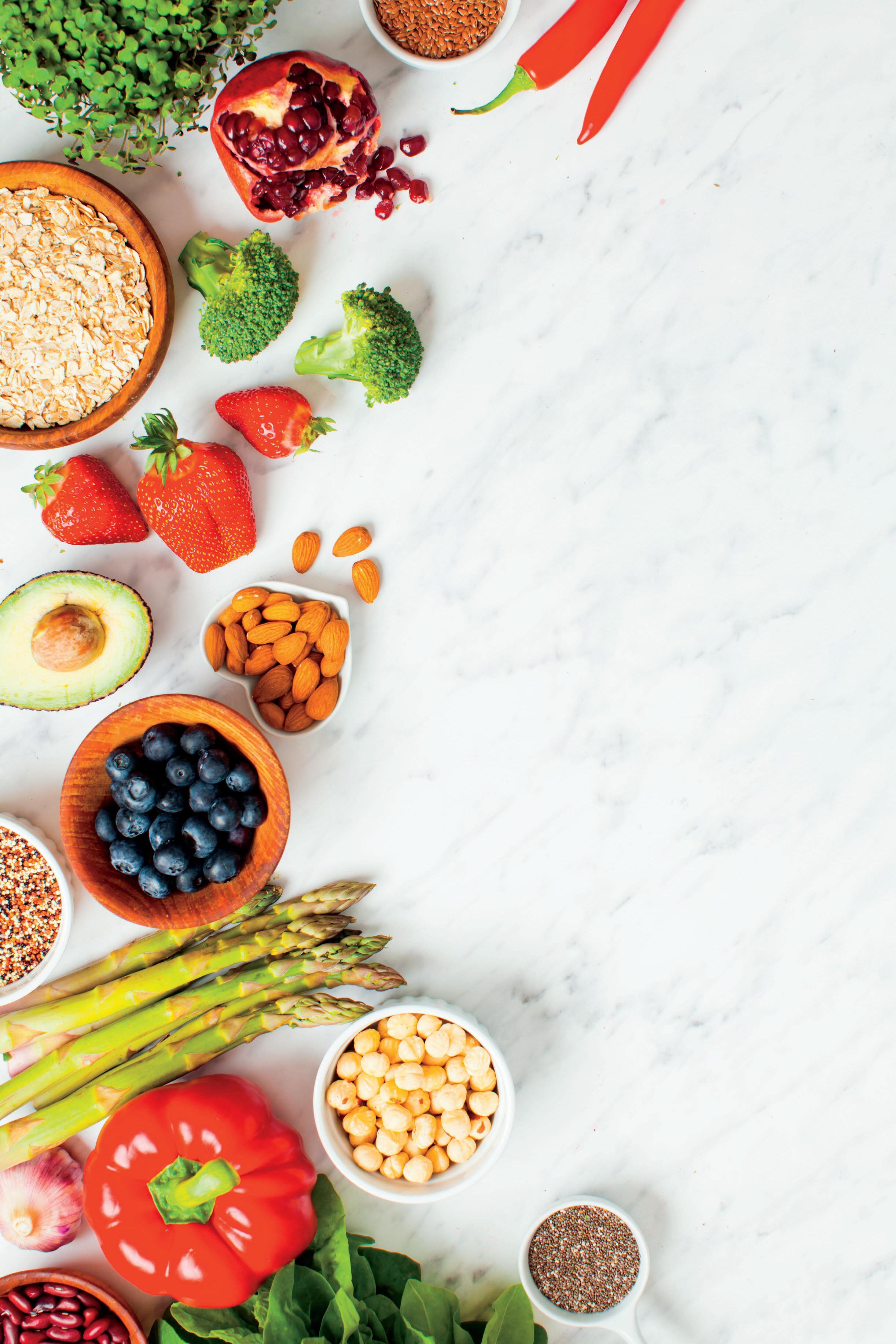
Grocery stores cash in by catering to our busy schedules Walk down the aisles and you will find convenient packages of pre-sli ced veggies, snack-sized containers of nuts, and trimmed and cleaned meats These foods often cost twice to three times as much as the whole food. Did you know you can buy a whole chicken for the same cost as two breasts at the grocery store? Consider buying the whole food and setting aside time when you return from the store as “ prep time ” Wash and cut produce, put snacks, such as nuts or crackers int o snack-size bags or containers, and trim and break down meats Although it is a bigger time commitment upfront, what you spend in time will often save you money
4. Less meat, more plants.
Make your money last a little longer by loading up with less expensive items such as filling greens and veggies, healthy fats (avocados and nuts), and high-fiber carbs (quinoa and lentils). High-quality meat is not cheap, especially when you a re trying to feed a large family Plan on at least half of your plate at every meal being plant-based, and this will be great for your health and your wallet Consider trying non-meat sources of protein or taking part in Meatless Monday to help keep you on budget You can also check out Where is the Beef? series for more delicious and nutritious meatless recipes
5. Plan. Plan. Plan

Meal planning is by far one of the most underutilized, but incredibly important tools in your toolbox for staying healthy and on budget Set aside time to plan out your meals and snacks for the week and make a grocery list based on that plan Look for sales and deals to help decide on ingredients and choose meals where you can repurpose the leftovers. Buying chicken, whole grain wraps, brown rice and veggies can give you a stir fry, salad, ve ggie wrap, chicken and rice bowl and whatever other combination you enjoy. Taking the extra steps to plan will help you stay healthy and will keep you from buying things you do not need

E A T I N G
Tasty food does not have to break the bank. With a little planning, it is possible to balance healthy eating and your finances.
16
Oct. 6 - Dec. 23, 2023
PurpleRoseTheatre.org
New Living Showroom
Featuring Sub Zero, Wolf & Cove Premium & Modern High Quality Appliances


GE Monogram, GE Cafe, GE Profile, Speed Queen, GE, Frigidaire, Asko, Bertazzoni, Bosch, BlueStar, Electrolux, Fisher & Paykel, KitchenAid, Maytag, Perlick, Vent-a-Hood, Viking, Whirlpool, Zephyr
Delivery & Installation
White glove service No boxes, wrapping, or assembly We remove old appliances Service & Repair
Experienced professionals * * * * * 734 475 1221 - Sales 734 662 0641 - Service www heydlauffs com

a p

17
Tasty. Healthy. Cheap. Budget-Friendly Recipes with Exciting Flavors
by Kevin Tatar
This soft-covered cookbook, published in 2023, is full of enticing photographs and quick-preparation recipes. It includes plenty of fresh ingredients, use of herbs, and spices.
Mr. Tatar is self-taught, therefore doesn’t follow standard culinary rules, to the benefit of the reader. The recipes are easy to adjust based on what you find in your kitchen (parsley or dried herb instead of fresh cilantro, for instance).
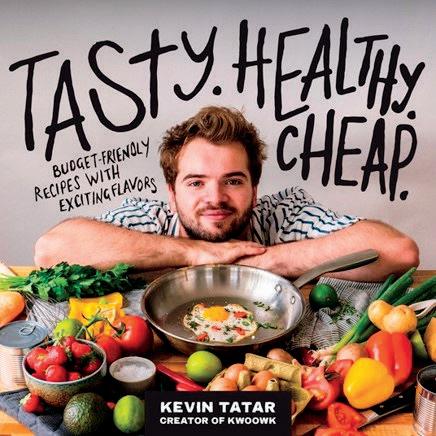
If you are a vegetarian/vegan or low-carb consumer, there is still plenty to work with, but you’ll have to make some adjustments. Of course, those with restrictive dietary habits already know how to use spaghetti squash instead of pasta or alternatives to cheese.
Cooking at Home. Or How I Learned to Stop Worrying About Recipes
(and love my microwave)
by David Chang & Priya Krishna
Published in 2021, Mr. Chang and Ms. Krishna have taken a highly creative approach to a cookbook. In each section they have a dialogue, sometimes with differing opinions. They often bring family and international culinary knowledge to the reader. Even the most experienced cooks will learn something from these pages.




The book is also designed in an unusual way with bright colored pages, colorful text, and graphics. Guidance doesn’t always include weights and measures, sometimes saying things like “Then add a bunch of spinach…” This shouldn’t be a surprise, based on the title of the book.


This is a fun and intriguing book.
Written by Amy Heydlauff
BOOKS PODCASTS For You! AND
Zoe Science & Nutrition

is a weekly podcast with titles like The Truth About Organic Food, Is Dairy Good or Bad for You, How Snacking Impacts your Health, Heart Health and Aging, and Protein and Exercise.

The podcasts last anywhere from 15 minutes to an hour and feature experts on that episode’s topic of discussion. The podcaster, Jonathan Wolfe, is always wellprepared with probing questions. He has a pleasant English accent.

After listening to half a dozen podcasts on issues related to kids, your gut, food’s relationship to exercise and energy, and aspects of aging, it seems the science is sound and there is plenty to learn.
There is a ‘Zoe’ and a corresponding website which touts products, including testing to determine your own dietary needs. The website links to plenty of research. But it is not promoted heavily during the podcasts and there is no expectation to visit the website. The science they rely on is real and they do us the favor of making it easy to access and understand.
Food, We Need to Talk
Talk is a podcast hosted by Edward M. Phillips, MD, an Assistant Professor of Physical Medicine and Rehabilitation at Harvard Medical School and is Founder and Director of the Institute of Lifestyle Medicine (ILM).
His co-host, Juna Gjata, is a Harvard graduate, with a degree in cognitive neuroscience. She describes herself as a certified perfectionist, recovering box-checker, and unapologetic Starbucks fanatic.
This podcast is relatively short (20-50 minutes) with topics like A Healthy Relationship with Unhealthy Food, Supplements and Snake Oils, Stress and Your Waistline, Is Your Brain on Cheesecake, and Doomed if you Diet, Doomed if you Don’t.
The hosts are entertaining, and the information is science based. There is humor and friendship. It is full of encouragement and reality. Worth the listen.
18
HUDSON MILLS METROPARK |
4 – 6 p.m. | Trunk-or-Treat & Dance Party
5 – 7 p.m. | Dog Activities
OCTOBER 28
Get dressed up and come out to Trunk-or-Treat from park vehicles like a dump truck and police car. Bring your four-legged family members
and visit the dog friendly activities for a tail-waggin’ good time.
Fall is a great time for hiking, biking and paddling at the Metroparks. Visit one or all of the Metroparks to soak in the fall colors and enjoy the cooler weather.


We have a whole schedule of exciting fall events scheduled this season including Halloween fun, birding, guided hikes, pumpkins and hayride programs available on our website.


19 METROPARKS.COM/FALLFUN Huron Meadows Metropark Kensington Metropark Hudson Mills Metropark Delhi Metropark Lower Huron Metropark Willow Metropark Lake Erie Metropark Lake St. Clair Metropark Wolcott Mill Metropark Stony Creek Metropark Dex ter-Huron Metropark OAKLAND LIVINGSTON WAYNE WASHTENAW MACOMB Oakwoods Metropark Indian Springs Metropark
PET FRIENDLY EVENT
ReThink the Morning Coffee and Donuts
Written by 5 Healthy Towns Foundation staff
Your Company Can Make the Healthy Choice the Easy Choice
Is your company looking for an alternative to the morning coffee and donut routine? Donuts are delicious, but to establish healthy guidelines in the workplace, studies show a strong relationship between a healthy physical environment and employees making healthy choices.
Healthy meetings at work are a great way to support employees and advocate for better health. All you need is a company policy guideline and a declaration of commitment.
Consider the link between healthy eating and work performance. Studies show that food choices contribute to calories that can sustain energy over a longer period of time. Healthy foods can boost brain power, decrease fatigue, and improve mood, all key indicators for increasing productivity and decreasing sick time.

One of the goals of Working Well is to provide employees with access to healthy food and beverage options, along
with opportunities for physical activity. Here are some tips for adopting a healthy meeting policy and communicating it to your workforce:

If your annual staff gathering is serving a meal, let employees know what will be provided. Include items such as fresh fruits and vegetables, water or infused water, low calorie drinks, lean proteins, and healthy snacks like nuts.
You may have employees with dietary restrictions, which is another good reason to have a range of options. More people are making food choices based on healthier eating, food tolerance and allergies.
Look at portions – smaller portions help employees diversify what they select.
Encourage your employees to move during meetings, by having standing or stretch breaks, or alternative activities for those with physical disabilities, to boost energy.
Add some healthy choices to your vending machines.
Walking meetings, or a brisk walk around the building with your coworkers, can also improve creative work relationships and good health.
According to Lorena Disha, Michigan Department of Health and Human Services, “access to healthier foods, beverages, and physical activity at work encourages healthier lifestyles among employees. Workplace policies that support healthy eating and physical activity throughout the day make it easier for employees to make the healthy choice the easy choice.”
20
If you’d like a sample meeting policy to adapt for your work setting, contact 5HF and sign up to receive more information from Working Well. For more information about Working Well, go to OneBigConnection.org and visit the Working Well Action Team.










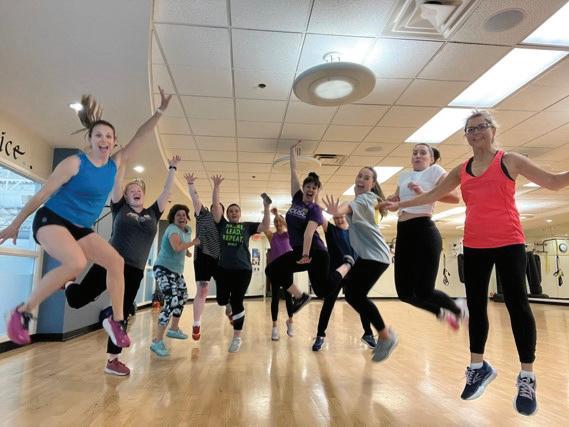







This information was provided by the Michigan Healthy Worksite Partnership, working together to build a culture of health and well-being at work. To learn more about the 10 Steps to Healthy Meetings, contact www.michigan.gov/ mdhhs/keep-mi-healthy/chronicdiseases/cardiovascular/ healthymeeting

Help











21 For Everyone! Be A Working Well Ambassador! Sign up at OneBigConnection.org/workingwell to see the benefits!
your workplace create a wellness culture
Weigh the Benefits of Creating New Healthy Habits

 Written by 5 Healthy Towns Foundation staff
Written by 5 Healthy Towns Foundation staff
How can losing weight and being more active improve your health? Ron and Pat Kohmescher in Manchester know firsthand how improving their lifestyle helped them feel and look better every day. They signed up for Chelsea Hospital’s Diabetes Prevention Program (DPP) and together lost more than 90 pounds by increasing their walking habits to four miles per day and making small changes to their eating habits.
“I was frustrated I couldn’t lose weight on my own,” said Ron. “But if you stick with the program by making the full-year commitment, it feels good to achieve your goals.”
“I was concerned because diabetes runs in my family and I also had risks for type 2 diabetes,” shared Pat. “But tracking what I ate and incorporating low-fat foods into my diet was the key to my success.”
Type 2 diabetes is a chronic disease caused by having too much glucose in our blood. We get glucose from the foods we eat when our body breaks down sugars and carbohydrates and carries them through our blood to fuel our bodies. When the glucose level is too high, it can lead to serious complications.

"As a DPP Coach, I know that monitoring what we eat is a great way to create healthier food habits, and prevent type 2 diabetes,” says Janine Staudinger, RN, and Diabetes Nurse Educator at Chelsea Hospital. “A year-long program may seem overwhelming to some people, but it has a proven track record.”
HERE ARE SOME SIMPLE TIPS:
• Keeping a food record can make you more aware and reinforce your healthy choices.
• Eat at regular times and try some mindful eating strategies. Mindful eating includes eating more slowly, not multi-tasking while you eat, and savoring each bite.
• Balance your calorie intake with your activity output – meaning, the calories we take in through our diet should not exceed the calories we burn every day.
• Be aware of subtle cues as to why you are eating, especially if you’re not hungry.
• Restaurant eating can be convenient, but it’s smart to plan ahead. Check out the menus in advance and stick to your plan.
According to Ron and Pat, “If you want to get healthy, sign up with a buddy and stick with it. If we can do it, so can you!”
1 in 5
37.3
 million Americans have diabetes, and 1 in 5 don’t know it.
million Americans have diabetes, and 1 in 5 don’t know it.
22




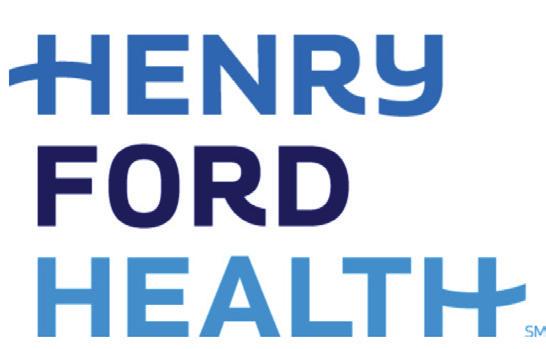



To check for a DPP class near you, contact: •Chelsea Hospital at chelsea hospital.org/diabeteseducation • Henry Ford Health at www.henryford.com/services/diabetes/education • Virtual classes through the National Kidney Foundation of Michigan, www.ReadySetPrevent.org HOUSING BUREAU FOR SENIORS Older adults face many challenges as they age, housing should never be one of them. housingbureauseniors@umich.edu If you have concerns about your housing (mortgage, property tax, rental, aging in place) please contact us. 734-998-9339 Housing Bureau for Seniors 23
It's Easy to Eat Better in the 5 Healthy Towns in the 5 Healthy Towns
Written by 5 Healthy Towns Foundation staff
DELICIOUS DISCOVERIES:
Since 2011, over 50 Eat Better initiatives have been supported by your 5 wellness coalitions and funded by 5HF. Slowing down when you eat, and selecting whole foods like fruits and vegetables, goes a long way to making more nutritional choices and maintaining a healthy weight. The programs listed focus on many strategies for improved health.
The wellness coalitions and foundation have spent over $1.4 million on programs addressing the idea of “Eating Better.” These programs strengthened farmers' markets, placed dieticians in local grocery stores, helped students pick thousands of pounds of locally grown produce, and have made our communities places where it’s easier to make healthy eating choices.
If you missed one of these offerings in your community, join your local wellness coalition discussion to ask if it can be funded again in the future.
In addition to the region-wide support for our local farmers markets and the annual Farm To Table dinner, here are the some Eat Better programs that community residents have enjoyed over the years.
Chelsea Intergenerational Garden – The Intergenerational Garden's mission is to teach children the joys of gardening, make gardening experiences available for seniors, and provide space and activities for multiple generations to enjoy each other’s company. Contact the Chelsea Senior Center for more information.
Dexter Winter Farmers Market –We are dedicated to supporting local growers and producers by providing Dexter and the surrounding communities with a friendly and welcoming Winter Farmers Market, which offers residents fresh food, local crafts and merchandise.


Grass Lake Vacation Bible School Healthy Snacks – Eight local churches in Grass Lake take part in a community‐wide vacation bible school program, and healthy snacks are essential for all participants.

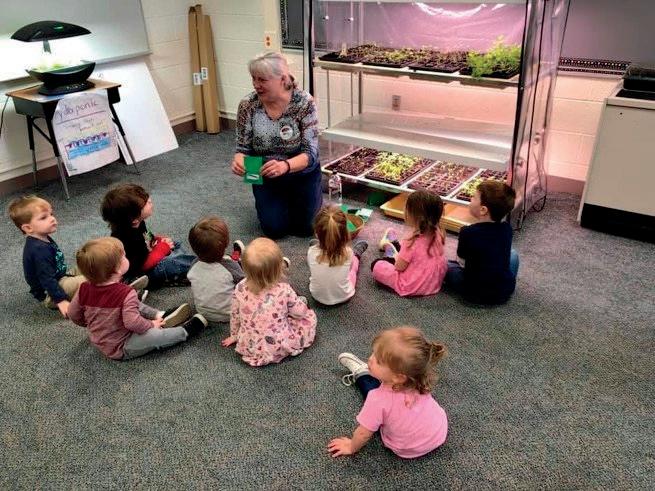
Manchester Library Seed Catalog – Small seed packages are distributed at the local library for local gardeners and home growers.
Stockbridge Community Outreach Cooking Workshops – Outreach cooking classes focus on the basics--how to shop for health and value; fundamental food preparation skills; and deciphering recipes. Participants make food in class and bring it home to share with family, along with some kitchen essentials such as cutting boards and knives.
24












25 (734)562-2552 1170 S. Main Street, Chelsea, MI 48118 www.horizonkitchenandbath.com Before When protecting your Auto, Home, Life, Business, Farm and more, the EXPERIENCE MATTERS. (734) 475-9184 | EderDiver.com 1250 S Main St., Chelsea Call Eder & Diver Insurance Agency today! MOBILITY MOBILITY WAVE is committed to providing accessible transportation for all. Contact us at 734-475-9494
BREAKING BREAD BREAD

HOW GROUP MEALS KEEP US CONNECTED AND ENGAGED
With the passing of beloved Bavarian Inn matriarch Dorothy Zehnder this past summer, memories of one of my favorite places, Zehnder’s Bavarian Inn in Frankenmuth, became front and center. The chicken dinners were always a highlight, and the Bavarian Village was heartwarming with relics from old German settlements. Just as important as the food is the shared laughter, storytelling, and passing of traditions among families and friends.
Shared family and community meals are common in all cultures, especially in the culture of our 5 Healthy Towns. Did you know that we also have our own famous chicken dinner right here in Manchester? This past season, the Manchester Chicken Broil celebrated its 70th anniversary of serving the community, and it is truly a community-wide event. Hundreds of volunteers and over 15,000 pounds of chicken served. More than 90 meals were donated back to families in need by Manchester’s Community Resource Center. It is easily the country’s largest single-day chicken broil event.


Our local senior centers offer community luncheons on a regular basis and celebrate the birthdays of their members. Churches and service groups host chicken broils, fish fry events, ice cream socials, and more. Chelsea Hospital offers free community meals on Thanksgiving and Christmas Day. There are so many that offer fellowship and food to those in need.
Community meals certainly keep us connected in a special way. To learn about more events like these, go to the Events link at OneBigConnection.org

W r i t t e n b y 5 H e a l t h y T o w n s F o u n d a t i o n s t a f f
Guests at the Manchester Chicken Broil
Cooking for a crowd at the Manchester Chicken Broil
Community meal at the Chelsea Senior Center











27 Serving RETAIL and FOODSERVICE customers. www.jiffymix.com www.jiffyfoodservice.com HEALTHY L I F E S T Y L E A CALM AND WELCOMING ENVIRONMENT TO UNWIND • COOKBOOKS FOR FRESH DINNER IDEAS • BOOKS, EBOOKS, AND VIDEOS WITH SELF-CARE, EXERCISE & WORKOUT TIPS V I S I T U S F O R : C H E L S E A D I S T R I C T L I B R A R Y O R G AFFORDABLE AUTO REPAIR! ALL MAKES » ALL MODELS » TRAINED TECHNICIANS 222 S. MAIN STREET, CHELSEA, MI (734) 475-1301 PalmerAutoService.Net Unbeatable Savings: Thanks to our strategic bulk oil buying, we're able to pass on massive savings directly to you. Say goodbye to overpriced oil changes and hello to affordability! KEEP RUNNING SMOOTHLY
January JanuaryDRY A MONTH OF SOBRIETY AND WELLNESS
 Written by Alex Duranczyk
Written by Alex Duranczyk
Dry January is an annual tradition where individuals choose to abstain from alcohol for the entire month of January. This January, the One Big Thing Action Team addressing alcohol awareness is promoting this movement to help community residents start the new year on a healthy note.
The concept is simple: Go alcohol free and give your body and mind a break.
There are many benefits to participating:
1. Improved Physical Wellbeing: It can lead to improved liver function, and a reduction in overall caloric intake, potentially leading to weight loss.
2. Better Mental Clarity: Taking a break can help you experience increased mental clarity, improved focus, and better decision making.
3. Increased Financial Savings: Alcohol can be expensive. With the savings you realize, you can
contribute to other goals or activities.
4. Better Sleep: You may find that your sleep improves, leaving you feeling more refreshed and energized.
5. A Needed Break from a Habit: Sometimes, alcohol consumption becomes a habitual behavior rather than a conscious choice. Dry January offers an opportunity to reevaluate your relationship with alcohol and reset your habits.

28
28
We invite you to join us in January 2024 and participate in Dry January. It’s a chance to develop strategies for socializing without relying on alcohol.




If you miss the social aspect of drinking, try exploring non-alcoholic beverages. Many alternatives are available that can still provide a sense of enjoyment during gatherings.
Dry January is more than just a detox—it’s a chance to evaluate your relationship with alcohol and discover the benefits of sobriety. Remember that taking part is a personal choice, and the positive impacts can extend beyond the month itself. Whether you’re looking to make a lasting change or simply press the reset button, Dry January offers an opportunity to prioritize your well-being and start the year off with a fresh perspective.

JANUARY Improved physical health. Boosted energy. Sharper concentration. Enhanced mental health. Fuller wallet. Endless opportunities.
29
AQUA CLASSES
Water Babies
For toddlers ages 0 -2 who need an adult to be with them in the water. This class will have a focus on water safety and will primarily feature songs and games. This will take place in the warm water pool. Min.3 Max. 10 participants Thursday
AQUA CLASSES
Level 4 Swim
For students ages 7-14 who are familiar with several swimming strokes, but cannot swim who full laps without stopping. Students should be able to swim 25 meters (one length of the pool) before participating. This class will take place in the lap pool. Parents are not required. Min. 3 Max. 6 participants
Tuesday 9/5-10/17 & 11/7-12/19
Saturday 9/9-10/28 & 11/11-12/23
Sunday 9/3-10/15-11/12-12/17
No Classes 9/16-9/23 & 11/20-11/25
Preschool Swim
For younger students, ages 3-4, who would benefit from a smaller class size. This class will have a focus on water safety, floating, and blowing bubbles. This class will take place in the warm pool. Parents are welcome to join, but not required. Min.4 Max. 5 participants
Level 5/6 Swim
6:50 pm –7:20 pm
12:20 pm –12:50 pm CHE




9:20 am –9:50 am DEX
For students 7-16 who are interested in training to become competitive swimmers in middle or high school. Students should be familiar with all strokes and be able to swim two full laps prior to enrollment. This class takes place in the therapy pool. Parents are not in the water. Min. 3 Max. 6 participants
Saturday 9/9-10/28 & 11/11-12/23
No Classes 9/16-9/23 & 11/20-11/25
Adult Beginner Swimming
9:00 am –9:30 am CHE
For students ages 14+ who are either new to swimming, or are interested in rebuilding a strong swimming foundation starting with floating in the water. This class takes place in the therapy pool.
Level 1 Swim
For all students aged 4-8 who are not yet comfortable going under water. Class will focus on kicking, floating, blowing bubbles, and water safety. This class will take place in the warm pool. Parents not in the water. Min. 4 Max. 5 participants
Tuesday
Thursday
Saturday
Sunday
Monday
Friday
No Classes
Level 2 Swim
For students ages 5-10. Class will focus on kicking and scooping independently, breathing while swimming, and water safety. Students should be comfortable going underwater and floating with assistance prior to the start of class. This class takes place in the warm pool. Parents not in the pool. Min. 4 Max. 5 participants
Tuesday
Thursday
&
Friday
Level 3 Swim
For students ages 7-14 who are able to swim on their own a short distance but have not mastered any swimming strokes. This class will focus on developing stroke techniques, going underwater in the deep end, and water safety. This class will take place in the lap pool.
Parents not in the pool. Min. 3 Max. 6 participants
Tuesday
Thursday
Friday 9/8-10/20 &
Min. 3 Max. 6 participants
Saturday 9/9-10/28 & 11/11-12/23
9:20 am –9:50 am DEX No Classes 9/16-9/23 & 11/20-11/25
Adult Intermediate Swimming
This is for students ages 14+ who are familiar with one or more strokes but don’t have the endurance to swim multiple laps. Class will focus on fitness, but students will learn how to continue developing their stroke outside of class during lap swim. This class takes place in the lap pool. Min. 3 Max. 6 participants
Saturday 9/9-10/28 & 11/11-12/23
8:40 am –9:10 am DEX No Classes 9/16-9/23 & 11/20-11/25
Adult Fitness Swimming
For students 14+ who are interested in swimming for fitness. Swimmers of all levels are welcome, but students should be able to swim one lap before participating. This class takes place in the lap pool. Min. 3 Max. 8 participants
Saturday 9/9-10/28 & 11/11-12/23
8:00 am –8:30 am DEX No Classes 9/16-9/23 & 11/20-11/25
Homeschool Swim
The homeschool swim program is for older children, ages 7-16 years, in level 2, level 3 or level 4 that are available in the afternoon. This class takes place in the lap pool. Min. 3 Max. 6 participants
Level 2 Homeschool Swim
Tuesday 9/5-10/17 & 11/7-12/19 1:00 pm –1:30 pm CHE
Monday 9/11-10/23 & 11/6-12/18 1:00 pm –1:30 pm DEX

Level 3 Homeschool Swim
Tuesday 9/5-10/17 & 11/7-12/19 1:40 pm –2:10 pm CHE
Monday 9/11-10/23 & 11/6-12/18 1:40 pm –2:10 pm DEX
Level 4 Homeschool Swim
Tuesday 9/5-10/17 & 11/7-12/19 2:20 pm –2:50 pm CHE
Monday 9/11-10/23 & 11/6-12/18 2:20 pm –2:50 pm DEX
No Classes 9/16-9/23 & 11/20-11/25
***No Aqua Classes 9/16-9/23 & 11/20-11/25***
Registration Deadline September -October: August 30
Registration Deadline November -December: November 1
9/7-10/19
11/9-12/21 3:30 pm–4:00 pm
9/9-10/28 & 11/11-12/23 9:40 am–10:10 am CHE
9/3-10/15 & 11/12-12/17 8:00 am –8:30 am
9/11-10/23 & 11/6-12/18 3:30 pm –4:00 pm DEX No Classes 9/16-9/23 & 11/20-11/25
&
Saturday
Sunday
Monday
Tuesday 9/5-10/17 & 11/7-12/19 4:10 pm–4:40 pm Thursday 9/7-10/19 & 11/9-12/21 4:10 pm –4:40 pm Saturday 9/9-10/28 & 11/11-12/23 10:20 am–10:50 am CHE Sunday 9/3-10/15 & 11/12-12/17 10:00 am –10:30 am Monday 9/11-10/23 & 11/6-12/18 4:10 pm –4:40 pm Friday 9/8-10/20 & 11/10-12/22 3:30 pm –4:00 pm DEX No Classes 9/16-9/23 & 11/20-11/25
9/5-10/17
11/7-12/19 4:50 pm–5:20 pm
&
9/7-10/19
11/9-12/21 4:50 pm –5:20 pm
&
9/9-10/28
11/11-12/23 11:00 am –11:30 am CHE
&
9/3-10/15
11/12-12/17 10:40 am –11:10am
&
9/11-10/23
11/6-12/18 4:50 pm –5:20 pm
&
9/8-10/20
11/10-12/22 4:10 pm –4:40pm DEX
&
9/16-9/23
11/20-11/25
&
9/5-10/17
11/7-12/19 5:30 pm –6:00 pm
9/7-10/19 & 11/9-12/21 5:30 pm –6:00 pm
9/9-10/28 & 11/11-12/23 11:40 pm –12:10 pm CHE
9/3-10/15 & 11/12-12/17 11:20 am –11:50 am
9/11-10/23
11/6-12/18 5:30 pm –6:00 pm
Saturday
Sunday
Monday
&
9/8-10/20
11/10-12/22 4:50 pm –5:20 pm DEX
9/16-9/23
11/20-11/25
&
No Classes
&
9/5-10/17
11/7-12/19 6:10 pm –6:40 pm
&
9/7-10/19 & 11/9-12/21 6:10 pm –6:40 pm
9/9-10/28 & 11/11-12/23 1:00 pm –1:30 pm CHE
9/3-10/15 & 11/12-12/17 8:40 am –9:10 am
9/11-10/23 & 11/6-12/18 6:10 pm –6:40 pm
Saturday
Sunday
Monday
5:30 pm –6:00 pm DEX
11/10-12/22
No Classes 9/16-9/23 & 11/20-11/25
Filling the Grocery Gap A Case Study for Success

Access to fresh food is a vital condition for health and wellness. In rural communities, it can often be a complex task. It requires a multipronged approach of collaborators including government agencies or business districts, nonprofit organizations, and private businesses who care about the local food ecosystem and its residents.


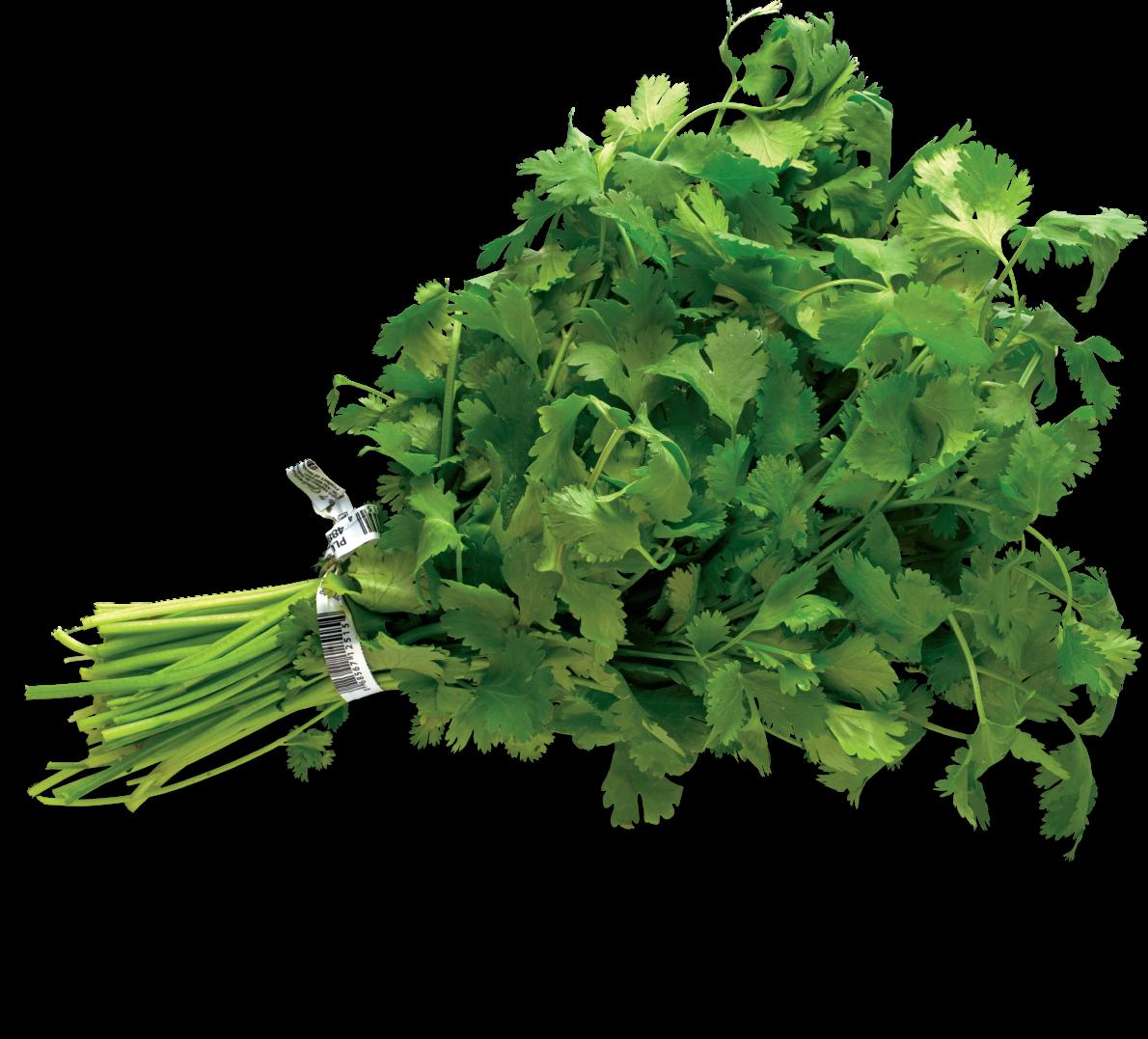
In 2020 we asked the question, “How often does distance to a full-service grocery store limit your ability to buy the variety and quality of fresh fruits and vegetables you would like? ” Very few respondents in Chelsea (5%), Dexter (2%), and Grass Lake (7%) indicated they always or usually had difficulty accessing produce. People responding from Manchester (36%) and Stockbridge (36%) were the opposite.

These numbers make sense with the 2019 closings of both the old Manchester Market and Stockbridges’ Ransoms Grocery. We asked the same question again with the 2022 survey and the numbers for Manchester and Stockbridge couldn’t have been more different. 13% of Manchester respondents said distance always or usually affected their ability to get fresh fruits and vegetables compared to 37% of Stockbridge responses.
Written by 5 Healthy Towns Foundation staff
What changed in Manchester?
The Manchester community looked at several different options to help fill the grocery gap. Manchester’s Downtown Development Authority put together engaging materials to help recruit a grocery to town, the Ladies Society hosted meetings exploring the feasibility of a food co-operative, Manchester Farmers Market discussed opening a farm stop style grocery store, while Manchester Community Resource Center addressed food insecurity.
Those efforts led to the formation of Acorn Farmers Market and Café. The non-profit retailer focused on buying local produce on consignment while also selling frozen proteins. Acorn eventually joined forces with several other food vendors in the old Manchester Market building. Acorn Farmers Market, Manchester Market, and Super Perky Pantry all opened in late 2020 supplying the community with fresh produce, local meats, good quality dry goods and other grocery essentials.
In 2023 Acorn Farmers Market returned to its traditional role of hosting Manchester’s Thursday Farmers Market while Manchester Market is thriving, providing the surrounding area access to quality food.
When community partners come together, pride, creativity and resilience abound. To learn more about Manchester Market and their goals to create a healthier future for the Manchester community, go to manchestermarketmi.com or stop by at 455 West Main Street, Manchester.
32
5 HEALTHY TOWNS SURVEY RESULTS
NUTRITION RELATED QUESTIONS


5 Healthy Towns Foundation conducted its 5HF Survey in Fall 2022. Thank you to everyone who participated and shared the links and articles about the survey! In the next few editions of Connected you’ll see the results from the survey questions paired up with pertinent articles about the data.
1365 adults over the age of 18 completed our survey. In this edition we will focus on our nutrition-related questions. We asked questions about Body Mass Index, Distance to Grocery Stores, Eating Habits, and Fruits and Vegetable consumption. The Distance to Grocery Store question was first asked with our 2020 survey. Body Mass Index, Healthy Eating Habits and Fruit and Vegetable Consumption are carryovers from the old Health Improvement Plan (HIP) surveys conducted in partnership with Washtenaw County Health Department and Chelsea Hospital.

One note about the BMI and Food Habit questions. In 2015 the HIP survey combined the results from Chelsea and Dexter together, while 5 Healthy Towns Foundation paid to oversample and break out Manchester. The 2010 HIP combined Chelsea, Dexter, and Manchester into Western Washtenaw County.
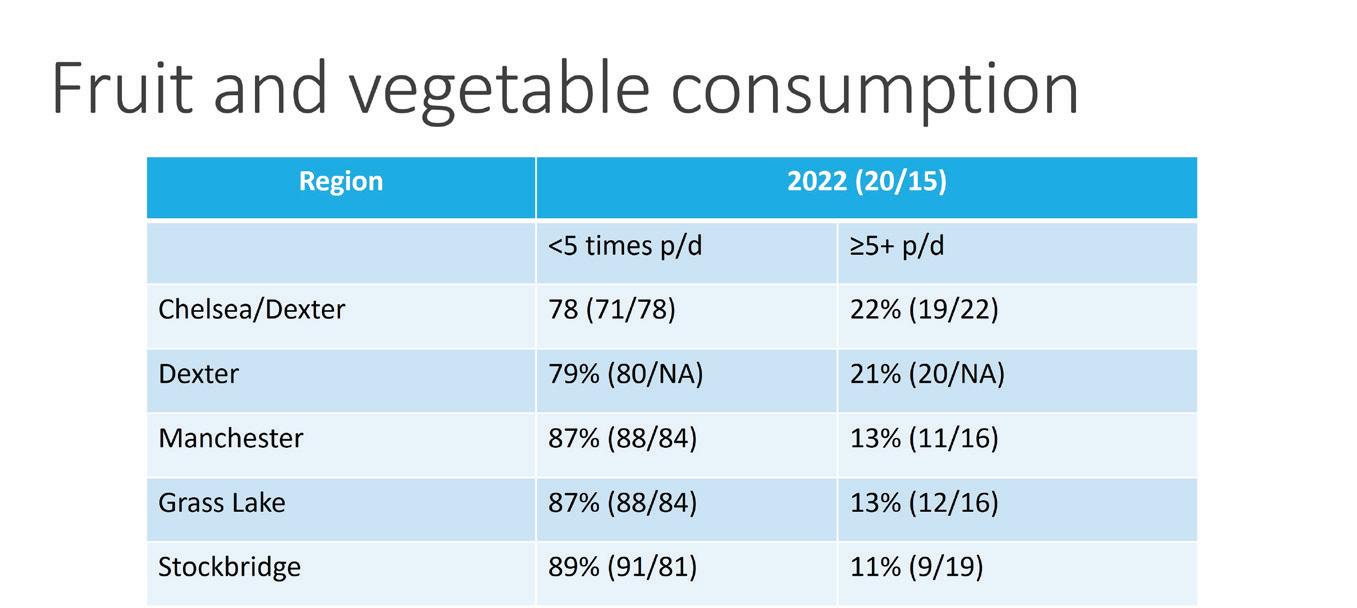

You can see the entire data report at www.onebigconnection.org/factsfigures.
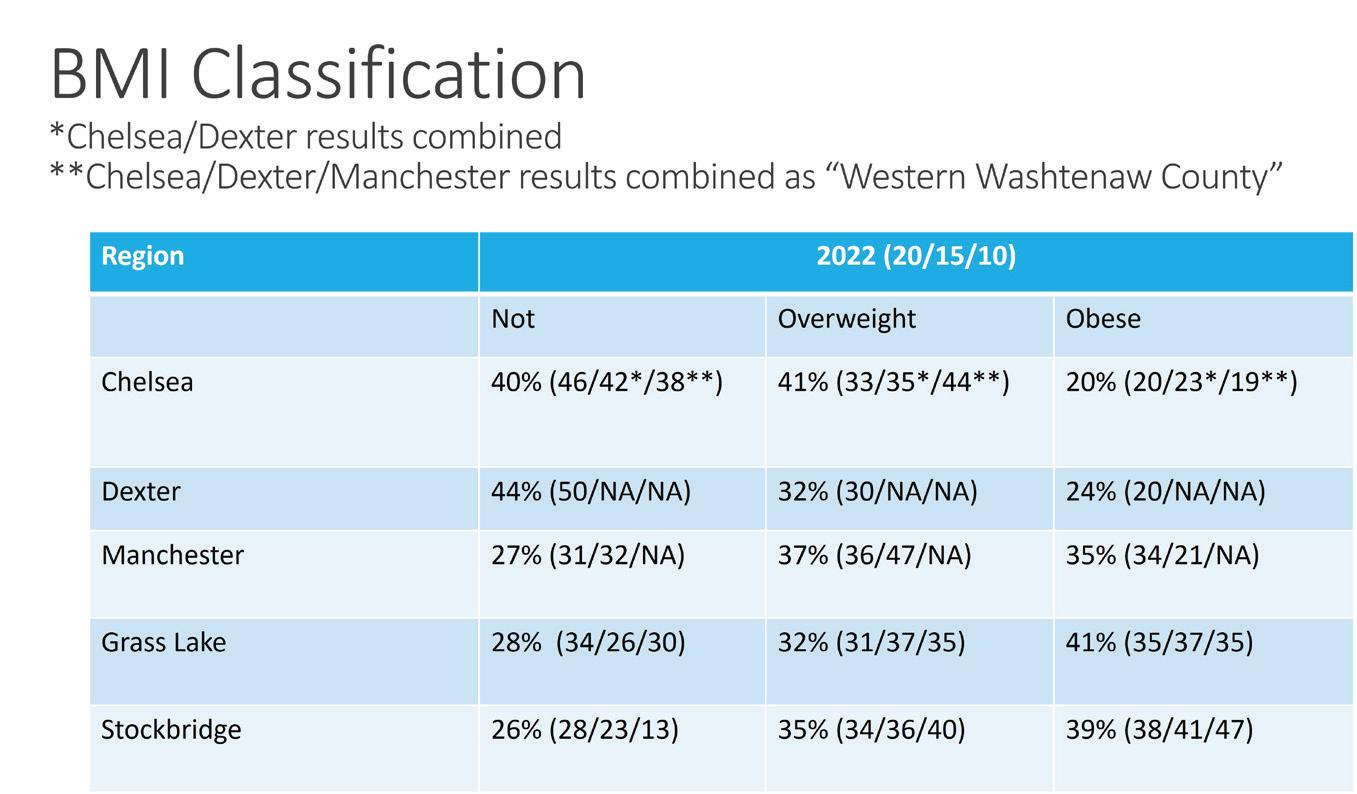
33
2022
33
IT'S ORGANIC!
Written by 5 Healthy Towns Foundation Staff
Although “organic farming” has been around for decades, my earliest memory of the word “organic” is from high school science class. My teacher, a retired professional from Midland Dow Chemical, expertly led the classroom discussions and experiments about compounds and organ structures. In college, I watched as my friends navigated their “organic chemistry” classes, which prepared them for future careers in the biological and medical sciences.
The Beginning The Labels

It wasn’t until the early 2000s that the word “organic” became part of our everyday language. Today, we see organic products, packaging, and processes everywhere, and we know it is part of the response to health hazards related to chemically formulated fertilizers, growth stimulants, antibiotics, or pesticides.

Organic farming practices focus on fruits, vegetables, grains, dairy products, and meat. The goals of organic farming include improved soil and water quality, reduced pollution, biodiversity, and creating a healthier environment for farm animals.
According to Mayo Clinic, diligence about label reading can help us determine the merits of the foods we buy. The U.S. Department of Agriculture (USDA) has set up an organic certification program requiring all organic food to meet strict government standards. If those standards are met, the product can be packaged with the USDA Organic label. Here is a cheat sheet.
Each ingredient (excluding salt and water) must be certified as 100% organic. Any processing aid used to manufacture the product must also be certified organic, meaning that the product cannot contain any nonagricultural ingredients such as baking soda or citric acid. The USDA also has specifications for where the label should appear if it is used.



In the United States, the Organic Foods Production Act of 1990 began the process of establishing enforceable rules to mandate how agricultural products are grown, sold, and labeled. There are three labeling categories in USDA Organic: allowable materials.
The product must contain at least 70% certified organic ingredients, and the remaining nonorganic agricultural ingredients may not be produced using excluded methods (ion radiation, genetic modification, sewage/sludge as fertilizers).
For additional information, go to the USDA National Institute of Food and Agriculture. www.nifa.usda.gov/ and search the expansive NIFA database.
34






35 Live Well With Us! From state-of-the-art fitness centers to enriching social and cultural experiences, our communities offer older adults and team members opportunities to LIVE WELL! . Learn more by visiting our communities in Chelsea or Dexter, or online at MyBrio.org.
Sewing Seeds of Community Togetherness
Written by Marianne Wendt, Dexter Farmers Market and 5 Healthy Towns Foundation staff
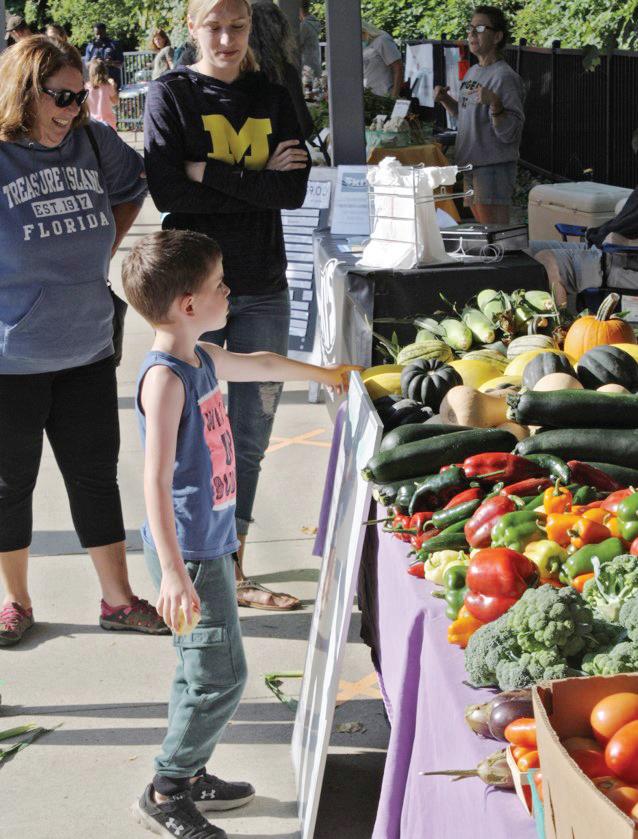
Amidst the hustle of modern life, farmers’ markets offer more than just farm-fresh produce and artisanal crafts. These vibrant hubs of local commerce hold the power to create strong community connections and foster friendships that endure beyond the market stalls.
Unlike supermarkets, farmers’ markets provide a direct link between shoppers and the growers or artisans. This transparency invites discussions about farming practices and sustainability, paving the way for deeper connections. By understanding the stories behind their purchases, consumers develop an emotional bond with the people who nurture the goods.
Farmers’ markets bring together people who are passionate about mindful consumption. These shared values form a solid foundation for new friendships. Conversations on eco-friendly practices and culinary adventures often lead to lasting bonds as kindred spirits find common ground.
In a world often characterized by isolation, our markets emerge as beacons of human connection and friendship. As
you navigate the colorful aisles of your local farmers’ market, remember that you’re not just buying goods – you’re cultivating relationships and sowing the seeds of community togetherness.
Our community members report that they love hearing the music as they approach the market, smelling the scents, and seeing the rainbow of colors in the spring and fall. Summer brings out even more people because it’s great to be outdoors! In the more isolated winter months, winter markets are beneficial to help us get out and connect.
The sense of community engagement that occurs at the market is one of our best community assets. “As a fun weekend tradition, my daughter looks forward to visiting the market and capturing photos of dogs, people laughing and dancing,” says Marianne Wendt, Dexter Farmers Market manager. “Supporting their local farms and artisans is a special treat, and our Dog of the Week reminds us that pets are important community members, too.”
36
Where can you meet new people and socialize, browse, shop, dance to music, pet a dog, and catch up with friends? At the local farmers market, that’s where.
Area residents of all ages enjoy visiting the farmers market
In true community spirit, many vendors help other vendors when needed –watching their booth if they need a break, setting up & cleaning up, and hanging tarps or sunshades. This community is where members learn from each other, especially during this past season which was a particularly hard growing season. Market vendors are loyal, returning year after year.

Farmers’ markets often host events and workshops that enrich the community experience. Cooking demonstrations, master gardening tips, and special events for kids to enjoy making crafts, story time, or dancing are offered while parents shop. It is a win/win for all ages!
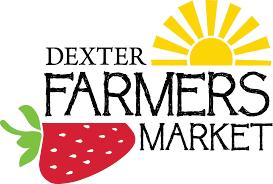
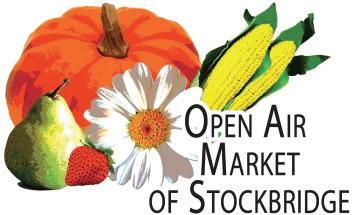





Networking and friendship-building begin at the market. Remember, you’re not just buying goods, you’re sowing the seeds of true community togetherness.

37 S t u n n i n g 1 8 H o l e C o u r s e F o o d & B e v e r a g e S e r v i c e O p e n t o t h e P u b l i c piercelakegolf.com P I E R C E L A K E G O L F C O U R S E 1 1 7 5 S . M A I N S T R E E T C H E L S E A
The
Healthy
has
marketsCheck out your local Farmers Market and enjoy all it has to offer!
Five
Towns
the following
PUTTING YOUR GARDEN TO BED
Written by Jennifer Fairfield, The Garden Mill in Chelsea
It’s fall, and gardening season is over, right? Well, maybe and maybe not. Before you hang up your trowel and start dreaming about next year, have you put your garden to bed?

“Putting your garden to bed” is simply a term used by gardeners to describe the tasks you should do after gardening season is over, but before winter sets in. Getting tasks done in the fall, instead of waiting until spring, helps in controlling weeds, ensuring that your plants have protection against winter weather, and giving your garden its best start next year. Here are some basic ways to get your garden ready:
In your vegetable garden, pull out plants once they have stopped producing. Composting most vegetable plants is a great way to feed your garden next spring but throw away any plants that have signs of disease, since diseases can hang around on plants and infect next year’s garden.
Some plants, such as kale, broccoli, cabbage, carrots, radishes, and beets, will survive a little frost but should be harvested before the ground freezes. Some herbs, including thyme and sage, can stay in the garden all year long, but will benefit from a layer of mulch, added after the ground has frozen, to protect their roots.
Once you have cleaned out your garden, consider doing a test to see if your soil is lacking any nutrients. You can add fertilizer or compost now, and once that’s done, add a layer of mulch to help prevent erosion and suppress weeds.
Be sure that your perennial flower gardens, trees, and shrubs are getting well watered all the way up until the ground freezes to give them the best chance of survival. Adding mulch around them, after the ground is frozen, will help to protect their roots from the freeze-thaw cycles we often get during Michigan winters.
Though some garden grasses and flowers are best cut back in the Fall, it’s usually a good idea to leave most standing over the winter, as they provide food and shelter for birds and beneficial insects. Raking leaves into the beds, instead of mowing them up or burning them, is another great way to provide warm hibernation spots for bees and butterfly larva.
When all your tasks in the garden are complete, don’t forget to take care of your tools. Empty, roll up, and put away hoses (tip: connecting the ends together keeps spiders from nesting in them). Put away sprinklers, watering wands, and sprayers. Clean and sharpen pruners, shears, and loppers, and then put them away where they will be easy to find next year.
Once you’ve done all these things, you can sit back with a cup of hot chocolate and plan for next year’s garden. Happy dreaming!
38
Written by 5 Healthy Towns Foundation staff
There are few things in the world that can compete with home cooked meals. So at this busy holiday time of year, what can you do to save some time or make your meal a little more Norman Rockwell and a little less Clark W. Griswold?

Here are some tips that can help:

Double the batch next time you’re prepping vegetables and put the extras in a freezer bag. Diced celery, onions, and carrots (mirepoix) are the basis for many traditional soups, stews, and sauces. Subtract carrots and add bell peppers and you’ll get the “Holy Trinity” used in Cajun cuisine like gumbos.
Multi-task your kitchen resources. The only unitasker in your kitchen should be your fire extinguisher. The ice cube tray is no exception. Use it for more than water by freezing leftover stocks and sauces. Transfer over to freezer bags and use as needed.
Plan your meal prep and cooking strategy. Complicated holiday meals have lots of moving parts. Plan your meal like Hannibal Smith by writing down a list of your dishes, the cook times, and temperatures. You can stagger what goes into the oven and control the chaos. Cold dishes like cranberry relish can be prepared the day before a dinner to open up your counter prep area, and cooking time.

Check the spices. Is the spice gone from your life? Open your cabinet. If you find spices in vintage metal tins or the spice rack you got as a wedding gift several years ago, it’s time for a refresh. Over time, spices may lose their flavor and potency. You can buy spices from online retailers in flatpacks and refill containers as needed. If you buy whole spices, grind them in an inexpensive 2.5-ounce coffee grinder. These small grinders are bad for coffee but great for spices.
Stay sharp out there. A leading cause of headaches and stitches in the kitchen is dull knives. If your knives aren’t cutting as easily as they used to, use honing steel and whetstone to maintain their edge. A honing steel will straighten your knife’s blade, while a whetstone will help restore the sharp edge. One other tip – buy a good pair of kitchen shears.

Know the power of the dark side. Our non-stick generation is learning what our grandparents knew – that cast iron makes a great cooking vessel. Every great thing needs some care, and cast iron is no different. Don’t soak or let water stand in your skillet. Put a little water in your pan and let it simmer for a few minutes, scraping off any leftover bits with a wooden spoon. After it’s dry put a small amount of vegetable oil in the skillet and wipe it off with a paper towel to keep the seasoning intact.

39
The ability to maintain physical health is complex, with many individuals over-focusing on behaviors they should be doing to be healthier. This is especially true when it comes to eating behaviors and diet. Dieting is one common method used to manage weight or influence overall health, however, the reality of making dietary changes is more complicated than a “calories in, calories out” mentality. Food is culture, tradition, and family. Food is an integral part of life’s enjoyment. When food is thought of simply as fuel for the body, it ignores the larger role that food plays. This is one of the reasons why diets often fail.
A health psychologist is someone who can support an individual in making the changes recommended by a medical provider, including changes to one’s diet. Health psychology seeks to promote health-related behavior change and illness prevention. For instance, common difficulties that a health psychologist can assist with regarding dietary changes include addressing eating habits when there is a shared household, not having time to cook or disliking cooking, financial restrictions, or frequently using food for comfort or as a reward.



BELOW ARE SOME APPROACHES TO MAKING HEALTHIER DIETARY CHANGES:
• Unless recommended by a medical provider, try not to cut out foods entirely. Extreme restriction tends to lead to more cravings for those foods which increases risk for over-consuming those foods when an opportunity presents itself.
• There is no such thing as “bad” foods; some foods simply have more nutritional benefit than others. Focus on adding in more nutritious foods to meals.
• Listen to the body’s cues when it comes to feeling hungry and full. Try pausing before refilling your plate to see if it is hunger or something else driving the desire to eat more.
• A meal wheel or recipe list can help plan the week’s meals. Making a grocery list based on the week’s recipes can reduce impulse purchases, improve budgeting for groceries, and reduce food waste.
When it comes to making dietary changes, it is important to recognize the more complex relationship that exists between food and eating behaviors. While it may seem overwhelming to make changes to diet or eating behaviors that can last, small behavioral changes are often more beneficial and longer lasting.
If additional support is needed, a health psychologist can help an individual identify and implement the changes desired to achieve a healthier lifestyle.
Helps achieve and maintain a healthy weight Helps the digestive system function Boosts immunity Strengthens bones May help you live longer Lowers risk of heart disease, type 2 diabetes, and some cancers Supports healthy pregnancies and breastfeeding Keeps skin, teeth, and eyes healthy Supports muscles TO LEARN MORE VISIT cdc.gov/healthyweight/healthy_eating April 2021 40
















41 Join our 2030 Campaign to grow $2.8 million endowment to $4 million chelsea@cfsem.org 734-475-9891 Learn more, subscribe to our newsletter and Donate! chelseafoundation org Chelsea Community Foundation leads and collaborates to bring permanent, positive change in Chelsea through thoughtful giving Grant Recipients 2023 Chelsea Chamber Players - $15,000 Huron River Pathways Initiative, Timbertown - $25,000 Washtenaw Area Value Express WAVE - $25,000 Supporting All Things Chelsea
FUNDRAISING KICKS OFF & ENDS DURING HALF TIME AT CHELSEA vs. DEXTER FOOTBALL GAME OCTOBER 20, 2023 Enhance educational experiences by financing projects that cannot otherwise be funded by the school district CEF & EFD OCTOBER 1
Timbertown Photo courtesy Dave Kuntz
GARDENS GARDENS
With an Inspired Vision, Any Garden Can Be A Healing Garden

Plants and flowers often provide us with joy, peace, healing, and inspiration to meet life’s challenges. Medicinal herbs and botanical gardens help us connect with nature and give us space to pursue creativity and serenity. Healing gardens are now commonplace in medical and therapeutic environments for people from all walks of life to enjoy, and they can even be accessible in your own backyard or on your patio.
Research shows that gardening and the physical activity that comes with digging, planting, and weeding, is a great way to give us a break from everyday stress. Urban gardening, on rooftops and repurposed parking lots, has received even more attention recently, as urban planners look to gardens to reshape the nutritional environment and promote social community connections. It can be as easy as filling a planter with aromatic herbs like lavender and sage or designing a more elaborate healing garden with colorful flowers, vegetables, or fruit.
You can turn any garden into a healing, nurturing environment by following a few design rules:


•Grow plants that you find pleasing. Edible flowers and plants can also be used for aromatherapy.
• Include a comfortable sitting area, to create a place to observe the beauty of nature.
• Add a focal point, like a sculpture, fountain, or a community labyrinth like the art at St. Barnabas Episcopal Church in Chelsea. stbarnabaschelsea.org/ labyrinth/
The St. Barnabas community labyrinth is open to anyone in need of a nurturing, peaceful environment. Alan Jensen, congregation member, was instrumental in establishing the Peace Garden there, and the adjacent labyrinth created by many congregation members offers native plant species and an accessible place for prayer and reflection.

“The goal in developing the Peace Garden and Labyrinth was to provide a community resource to promote spirituality and biodiversity,” said Jensen. “The Peace Garden was a 15- year project, and close to our hearts. Biodiversity promotes species development and supports all living native plants. It aligns with our goal to welcome a diverse congregation.”
At Chelsea Hospital, the healing garden is a vital part of patient care. The courtyard and gardens are open yearround for patients, families, visitors and colleagues for a brief reprieve or walk. During the warmer months, patients also have the opportunity to tend to plants in the serenity garden. The garden serves as a healing environment for body, mind, and spirit.
“In the work I do,” said Blair Arbaugh, urban garden consultant, “there are so many aspects to consider. We encourage people to have an open mind to accept the stewardship of the land, and the responsibilities for things you can control in nature. Mindfulness is so important to how we embrace the land and gardens around us. Being still enough helps us realize and observe the beauty of a healing garden.”
42 HEALING HEALING
W r i t t e n b y 5 H e a l t h y T o w n s F o u n d a t i o n s t a f f
Saint Barnabas Peace Garden
Chelsea Hospital healing garden
Peace Garden in Bloom
(ringing








43 DEXTER COMMUNITY SCHOOLS • High Quality, On-Campus Early Childhood Programs • Farm-to-School Program and Local Food Initiatives • Award-Winning Academics, Athletics, Arts and Extracurriculars, including International Exchanges • Customized Learning Pathways to Engage All Learners • Cutting-Edge Technology Integration • Diverse High School Curricula: International Baccalaureate Diploma, AP Courses, Early Middle College, Career and Technical Education, and more! Engaging, personalized curriculum for every kind of learner! COME SEE WHAT WE ARE ALL ABOUT! dexterschools.org DR. MICHELLE RANKIN, Au.D., CCC-A Doctor of Audiology 734-433-0699 1600 Commerce Park Drive Suite 300 | Chelsea rankinhearing.com | drrankin@rankinhearing.com ASK US ABOUT: Hearing loss
loss
in the ears)
Memory
Tinnitus
or buzzing
Wax prevention and removal
aids
Dizziness and balance concerns Hearing
Hearing protection
more! Put our expertise to work for you. OBTP#B13696 © 2021 HRB Tax Group, Inc. DEXTER HRB, MI 48130 | 734-426-4313 CHELSEA HRB, MI 48118 | 734-475-2752
Communication strategies Sleep plugs, musician plugs, swim plugs, and
Does your lifestyle need a Nutrition Label review?
Written by Sophia Speroff, MPH, RD, Chelsea Hospital
Nutrition food labels have undergone the first major change in almost 20 years.
Reading a nutrition label can be tricky – it’s hard to know which information is most important to look for, and what recommended values, serving sizes, and more really mean. The new change to nutrition labels is intended to help you make quick, informed decisions to help you choose a healthy diet. These guidelines help promote a healthy eating lifestyle that can be maintained through all stages of life.
What’s Changed?
Serving sizes — These have become more standardized, making it easier to compare similar foods, providing familiar units in cups or pieces reflecting what people are likely to eat or drink.
Calories & fat — Larger print making it easier to see.
Added sugars — Shows the percentage from added sugars including brown/maple sugar, corn sweetener/syrup, honey, malt syrup and molasses.
Percent Daily Value (%DV) — The percentage of daily values have been updated – 5% DV or less of a nutrient per serving is considered low, and 20%DV or more of a nutrient per serving is considered high.
Dual Columns — If the item contains more than 1 serving, there may be 2 columns to provide calorie and nutrient information for 1 serving and for the entire package.
Nutrients required — Vitamin D, potassium, calcium, and iron are required. Vitamins A and C will no longer be required.
Serving Information
Look at the number of servings in the package (servings per container) and the serving size. This is the serving size people typically eat or drink. All the nutrient amounts shown on the label, including the number of calories, refer to the size of the serving. Pay particular attention to the serving size, especially how many servings are in the food package.
Calories
Calories measure how much energy you get from a serving of food. In the label below, there are 280 calories (about 22 minutes of running) in one serving, consuming the entire package, four servings, totals 1,120 calories (about 90 minutes of running).
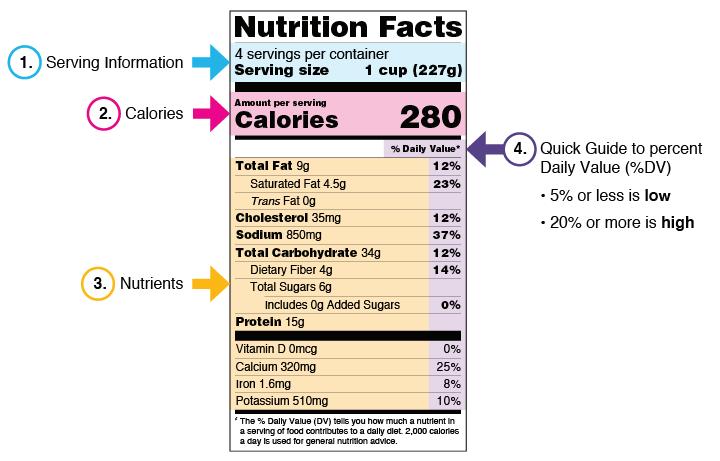
Nutrients
These key nutrients impact your health, including foods you want to get more of and those you may want to limit. Nutrients you want to limit include saturated fat, sodium and added sugars. Eating too much saturated fat and sodium may increase the risk of developing heart disease and high blood pressure. Total sugars include those naturally present in nutritious foods and beverages, such as milk and fruit. Added sugars include those added during the processing of food.
Healthy eating does not have to be overwhelming. Focus on one goal for the next couple of weeks and consider paying greater attention to nutrition labels. Once you feel comfortable with that — challenge yourself again with another small step to make your nutrition choices a lifestyle change!
44
According to the National Institutes of Health (NIH), research on oral health extends far beyond your teeth. Researchers consider your mouth as a “living laboratory,” and a window into your overall health. Based on studies, the prevention and treatment of health problems in your mouth could also guide efforts to medically treat organs and tissues on a broader scale, like cardiovascular health.
In everyday language, your oral health is important. The World Health Organization defines oral health as the state of the mouth, teeth and orofacial structures that help you perform important functions – such as eating, breathing, and speaking. It affects self-confidence, well-being, and the ability to socialize and work without pain or embarrassment. It impacts your quality of life.
Over your life span, oral health is just as important in young children as it is to healthy aging. Oral diseases are among the most common noncommunicable diseases worldwide, affecting an estimated 3.5 billion people. That’s why regular dental check-ups are important for individuals at all stages of life.





Keep Your Mouth Healthy
Written by 5 Healthy Towns Foundation staff

45
Adult Learners Institute of Chelsea, Michigan, Inc. We are about life-long Learning ALI offers a full curriculum of diverse classes with topics specially selected for adult learners. For more information visit: www.alimichigan.org Or call 734.292.5540 FUN? Tues-Fri • 10 - 3:30 JOIN THE 373 Lakes de Drive Grass Lake 517-522-8466 GRASSLAKESENIORS ORG Grass Lake Senior Center Lunch Served Daily Senior Resources Dance & Exercise Classes Games ALL DAY (Bingo/Euchre/Skipbo & More) Ready to
Written by Lauren Grossman, Food Gatherers Communications Coordinator
Food Gatherers Creating a Food Secure Future
Washtenaw County is among the most desirable places to live in Michigan, but it is also one of Michigan’s most expensive communities. Many of our neighbors struggle with food insecurity, lacking reliable access to affordable, healthy food. As a result, many face impossible choices, like skipping meals to pay for rent or medical care.
For the last 35 years, Food Gatherers, Washtenaw County’s food bank and food rescue program, has been dedicated to ensuring everyone in our community has access to the food they need to thrive.
Food Gatherers collects millions of pounds of food each year through retail food rescue, government programs, and individual donations. The donations are distributed through a network of more than 140 partner programs and agencies throughout the county.
In addition, the food bank operates its own programs to fight hunger, running the Community Kitchen in Ann Arbor and sponsoring the Summer Food Service Program for kids and teens who don’t have access to school meals during the summer months. This year, the summer meal program launched a new Meet Up and Eat Up site serving families in Dexter.
Food Gatherers works toward equitable access to resources, regardless of where you live. The staff and volunteers identify and address barriers faced by our neighbors, and increase their opportunities to access healthy, culturally relevant food.
In rural communities, transportation can be a significant barrier. Those who lack a reliable vehicle, do not live near public transit, or live with mobility issues can find it difficult to reach the nearest grocery store. Food Gatherers partners with local agencies in Manchester, Chelsea, and Dexter to stock pantries in locations that suit the needs of those communities and develops new programs to get food into the hands of those who need it.
Recently, Food Gatherers helped secure a USDA grant for Aid in Milan and Manchester Community Resource Center. They purchased a van to expand homebound delivery and popup distributions.


Every community is unique, and working with partners and neighbors helps Food Gatherers understand what a thriving, food-secure community looks like to them. By listening to neighbors’ experiences and addressing challenges together, we can create a food-secure future that benefits everyone in Washtenaw County.

You can help fight hunger. Visit FoodGatherers.org to learn more about getting involved as a volunteer, donor, or advocate.
If you need food, please contact Food Gatherers for information on free grocery and meal distributions near you. Call 734-761-2796 or visit FoodGatherers.org/FindFood.
46
Food Gatherers secured an $85,000 USDA grant to expand services in areas where residents do not have access to public transportation. (Photo by Manchester Community Center.)
Last year, Food Gatherers distributed 7.8 million pounds of food, the equivalent of 6.5 million meals to people facing food insecurity. [Photo by Manchester Community Resource Center]
HUNGER LOOKS LIKE? D0 YOU KNOW WHAT
Written by 5 Healthy Towns Foundation staff
The “I Am Hunger in America” campaign is compelling. You may have heard the public service announcements on the radio while driving.
One in seven children faces hunger in our country, and the campaign highlights many bios and stories to give a face to a national crisis. Many of us don’t recognize those faces when we see them. Hunger takes many shapes and forms. Knowing the facts about hunger can help us see it with care and compassion. 40 million Americans struggle with access to food, and children are at highest risk. 78% of the counties nationwide with people at highest risk are in rural communities.
FeedingAmerica.org is the largest hunger relief organization in the United States. Representing a nationwide network of food banks, food pantries, and community-based organizations in the United States, they work to end hunger by providing food and support to millions of people.
Here at home, there are many community partners who have joined the fight against hunger and food insecurity. They look for donations and volunteers. They don’t turn anyone away.

Faith In Action – Chelsea and Dexter – faithinaction1.org
Grass Lake United Methodist Church – grasslakeumc.org
Grass Lake Family Worship Center Fresh Food Initiative – grasslakefwc.com
Manchester Community Resource Center – manchestercrc.org
Manchester Family Services – foodgatherers.org
Stockbridge Community Outreach and Tide Me Over – stockbridgecommunityoutreach.org
Dora’s Cupboard, Stockbridge Good Shepherd Mission – freefood.org
If you know of other food access services in the 5 healthy towns, we would like to include them on OneBigConnection.org. Please contact us at info@onebigconnection.org
Our local Farmers Markets also offer food assistance through the SNAP/ Bridge card program. If you are eligible for SNAP and use your bridge card at the market, the amount you spend could be matched with Double Up Food Bucks bonus tokens. See the market manager for details.
To apply for a Bridge Card visit Michigan.gov
47
Locals are caught making healthy choices all around our communities




Caught
THE ACT
48
IN
...
Silver Maples employees enjoying peace, love, and happy employment
Young swimmer at the 5HF Wellness Center
Brio Living Services employees compete in a friendly softball game
Farmers market supporters enjoy Farm to Table 2023


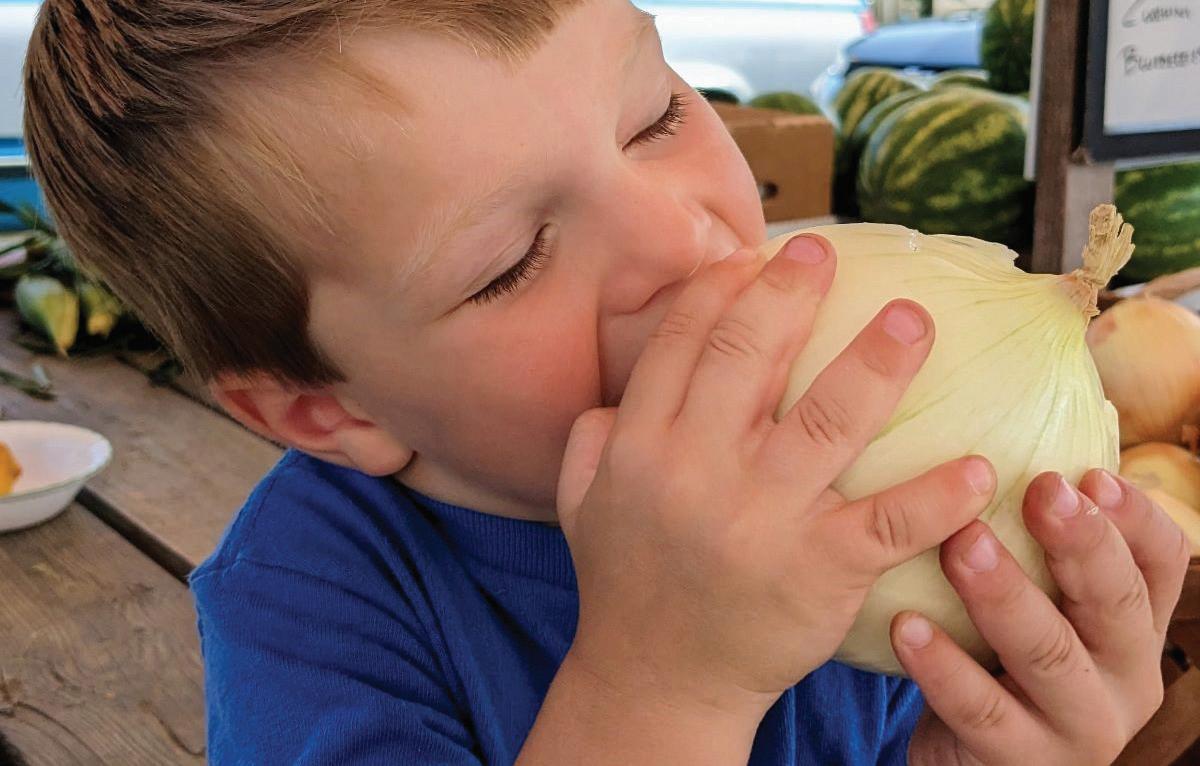

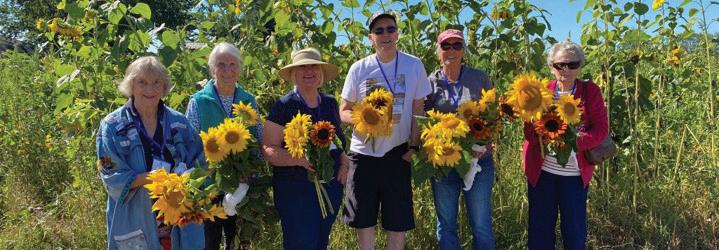

49
Enjoying a lunchtime break on the indoor track
Giovanni taste-tests locally-grown produce
The beauty of local sunflowers at the Chelsea Senior Center
Silver Maples employees enjoy the staff picnic
Stockbridge area youth riding on the new pump track
#5healthyteens volunteers check in over 100 youth at the annual 5HF ice skating event
An Apple An Apple An Apple A Day! A Day! A Day!
Written by
 5 Healthy Towns Foundation staff
5 Healthy Towns Foundation staff
Lesser Farms and Orchard
12651 Island Lake Rd.
Dexter
They are a family-owned and familyoperated 5th-generation farm. From farm-raised beef to home-grown fruits they take pride in supplying fresh, local food to our community. Every item was grown, raised, produced, or harvested from their land and family.
Dexter Cider Mill, Inc.
3685 Central St.
Dexter
Family-owned and operated since 1886, Dexter Cider Mill is the oldest, continuously operating cider mill in the State of Michigan. Be sure to stop by to enjoy delicious doughnuts, wood-pressed cider, caramel apples, apple nut bread, and many other scrumptious treats.

Sylvan Orchard

1746 Cavanaugh Lake Rd.
Chelsea
Established 1981 Reestablished 2015. 700 peach trees were planted in 1981 on the farmstead The peaches were inarguably the most delectable fruit in southeast Michigan. 34 years later, the orchard was replanted with a variety of cider apples and Perry pears.
Alber Orchard and Cider Mill 13011 Bethel Church Rd.
Manchester
Step back in history and explore the heirloom apples, award-winning cider, and fall activities. Only 30 minutes west of Ann Arbor or an hour from Detroit, the beautiful orchard provides a perfect country getaway in the rolling hills of Manchester

The Frosty Apple
6884 Walsh Rd.
Dexter
Small family apple orchard with lipsmacking apples and picturesque farm views. Enjoy the Michigan apple season at Frosty Apple Orchard! Apple pies and cookies are available, too.




The Schell Family Farm 10055 Dexter-Pinkney Rd. Pinckney
The Schell Family farm places a great deal of emphasis on our impact within the Community. Creating events that focus on bringing together friends and family, strengthening the bonds that build a better Community for all of us!

50
50
It’s apple season and there are several places in the 5 Healthy Towns area to get your fresh Michigan apples.
How many seeds are in an apple?



Where does Michigan rank in apple production?

3RD AT 1.1B

What is the Michigan Apple Committee (MAC)? What is





The Michigan Apple Committee (MAC) is a quasi-governmental organization dedicated to improving the profitability of Michigan's fresh and processed apple industries. MAC coordinates market development, educational activities and research that benefits the 1000 family apple growers in Michigan through improved profitability, ensuring the continued success of this sector of Michigan agriculture The Michigan Apple Committee consists of an odd number of members, not to be less than five or exceed 13 Members serve three-year terms Committee appointments are subject to the advice and consent of the Senate
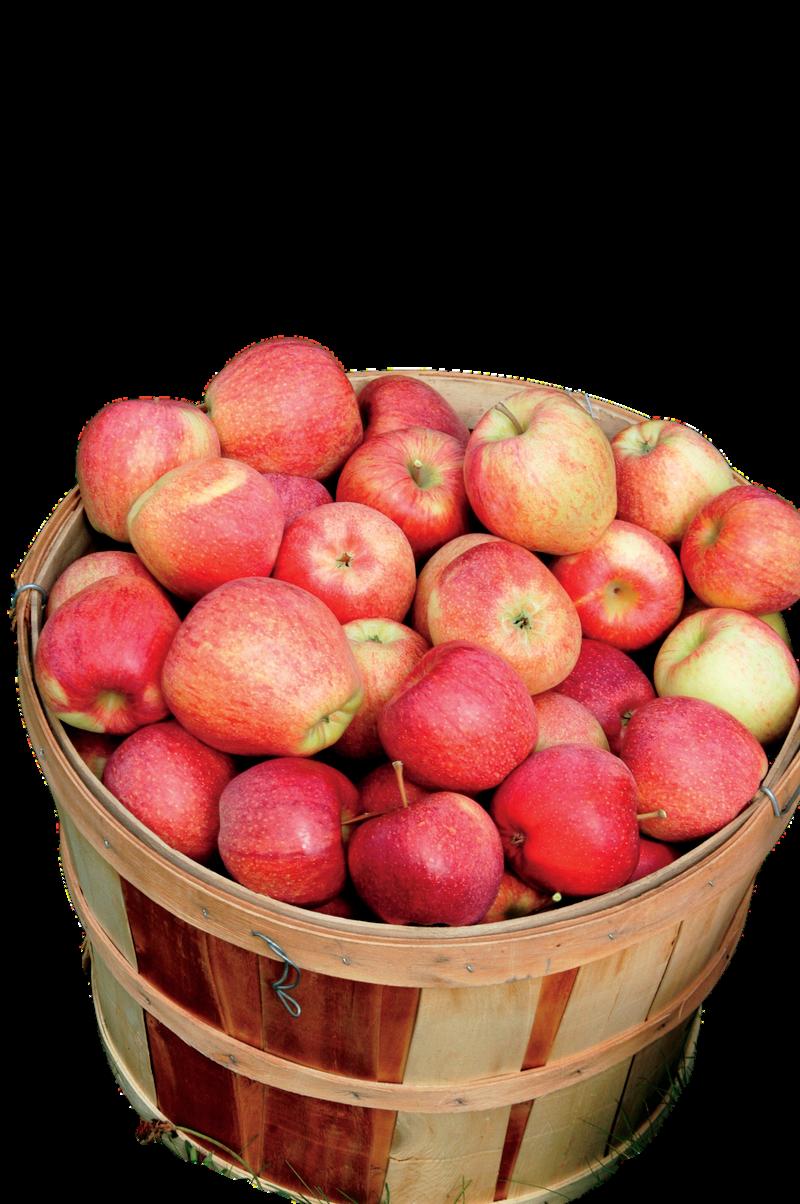

10 SEEDS B E H I N D W A S H I N G T O N – 6 . 5 B A N D N E W Y O R K – 1 . 4 B
775
W H A T I S T H E M I C H I G A N A P P L E C R O P 2 0 2 3 ? pple is Michigan known for? F O U N D E D B Y G E O R G E W I A R D I N 1 8 3 7 T H E O L D E S T C H A R D I N M I ? HONEYCRISP! FUJI AND JONAGOLD ARE ALSO CONSISTENTLY AT THE TOP OF THE LIST . O F T H E M A N Y F R U I T C R O P S I N M I C H I G A N , A P P L E S A R E T H E B I G G E S T A N D M O S T P R O F I T A B L E C O N T R I B U T I N G M O R E T H A N 5 0 0 M I L L I O N D O L L A R S T O T H E E C O N O M Y E A C H Y E A R
The Michian Apple Committee has estimated a crop of 29.5 million bushels.
A B O U T H O W M A N Y A P P L E S A R E I N A G A L L O N O F C I D E R ? 36!
APPLE BLOSSOM OF COURSE! Michigan 51
Michigan's state flower? THE
Preserve
Low- and No-Sugar JAMS & JELLIES
Whether fresh grape jelly to liven up a peanut butter sandwich or home-preserved strawberry jam for an ice cream sundae, homemade jams and jellies can make a good meal great. For the best results when making jam or jelly with little or no sugar, Michigan State University Extension recommends using a research-based recipe.
Sugar is the main ingredient that safely preserves most jellied products. Because of this, jams, jellies and preserves made with the standard amount of sugar may be off-limits for those who may be looking for ways to lower sugar consumption for health or lifestyle reasons.
Specially formulated pectin can ensure good wiggle room in making low- or no-sugar jams and jellies. If a regular recipe is used and the sugar is decreased or not added, the end product may not be successful.


Use one of the following methods to make low- and no-sugar jellied products:
Powdered or liquid pectin can be found in the canning supplies section at the grocery store, hardware store or online. Look for words like “light”, “less sugar” or “no sugar needed” on the label. Follow the manufacturer’s directions.
This article was published by Michigan State University Extension. For more information, visit extension.msu.edu.
To have a digest of information delivered straight to your email inbox, visit extension.msu.edu/ newsletters. To contact an expert in your area, visit extension.msu. edu/experts, or call 888-MSUE4MI (888-678-3464).
By Mary Donaldson, Michigan State University Extension
Some recipes that use regular pectin may call for sugar substitutes or other sweeteners. Regular pectin does contain some sugar, so this would not be completely sugar free. The National Center for Home Food Preservation has recipes that use unflavored gelatin as the thickener for jellied products. Consider making a fruit puree, which resembles a jam. With a puree, the fruit is boiled until the pulp thickens, so there is no added sugar.
After selecting a research-based recipe, read the directions several times. Not following directions may lower the quality of the end product, or even pose a food safety risk. To preserve the jam or jelly, use an approved method such as a water bath canner or atmospheric steam canner. For best quality, use the jam or jelly within one year. Recipes with low or no sugar are a great way to make your jam and eat it, too.
For more tips and tricks on canning and preserving a variety of delicious foods, visit canr.msu.edu/food_ preservation/
52
52
Updated from an original article written by Jeannie Nichols, Michigan State University Extension.
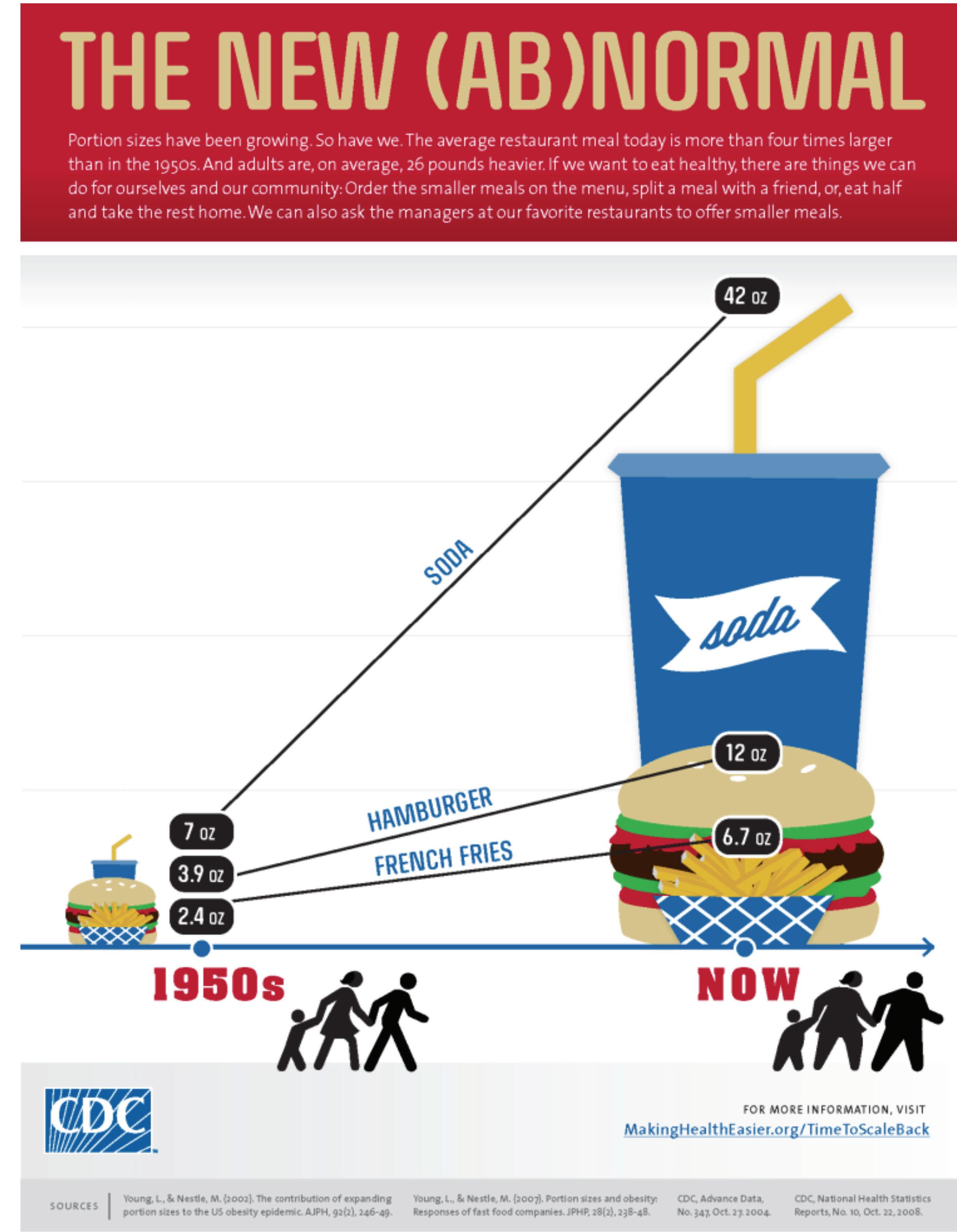
53 40 OZ 30 OZ 20 OZ 10 OZ
AVOCADOS
NUTRITIOUS, DELICIOUS AND VERSATILE.

Avocados can be a great source of nutrition. According to the United States Department of Agriculture (USDA), they are high in folate, potassium, vitamin E, vitamin K and other phytochemicals that can be an excellent addition to your diet. Besides their nutrient-dense nature, they are delicious and versatile. You can enjoy them on toast or in guacamole, chili or even smoothies. Fresh avocados are firm, and they soften as they ripen.
PREPARING
Do not wash fruit before storing it, because introducing moisture encourages early spoilage. Rinse the avocado under cool, running water just before consuming. Scrub the skin with your hands or a vegetable brush. Place the avocado on a cutting board and cut in half. Remove the seed as well as separate the flesh of the avocado from the skin. This can be scooped out or sliced. Prepare the avocado according to your recipe.
STORING
According to the National Center for Home Food Preservation, uncut avocados may be stored for up to five days in the pantry. Do not refrigerate prior to ripening. Once ripened, you may store the whole avocado in the refrigerator at 40 degrees Fahrenheit to slow down further ripening. Store cut up avocado in crisper drawer or moisture-resistant bags or wraps in the refrigerator. Wrap the cut avocados to prevent nutrient loss. You may squeeze lime or lemon juice to assist in preventing browning. They will keep for three to four days in the refrigerator.
PRESERVING
Avocados can be safely preserved by freezing, but when frozen, whole or sliced avocados do not maintain the best quality. Instead, freeze avocados as a puree and add one tablespoon of lemon juice for every two avocados, or 1/4 teaspoon ascorbic acid for every quart of puree. Leave headspace while packing the container. Seal, date, and freeze at 0 degrees Fahrenheit. Use within 12 months. There are no research-tested recipes for canning avocados at this time.
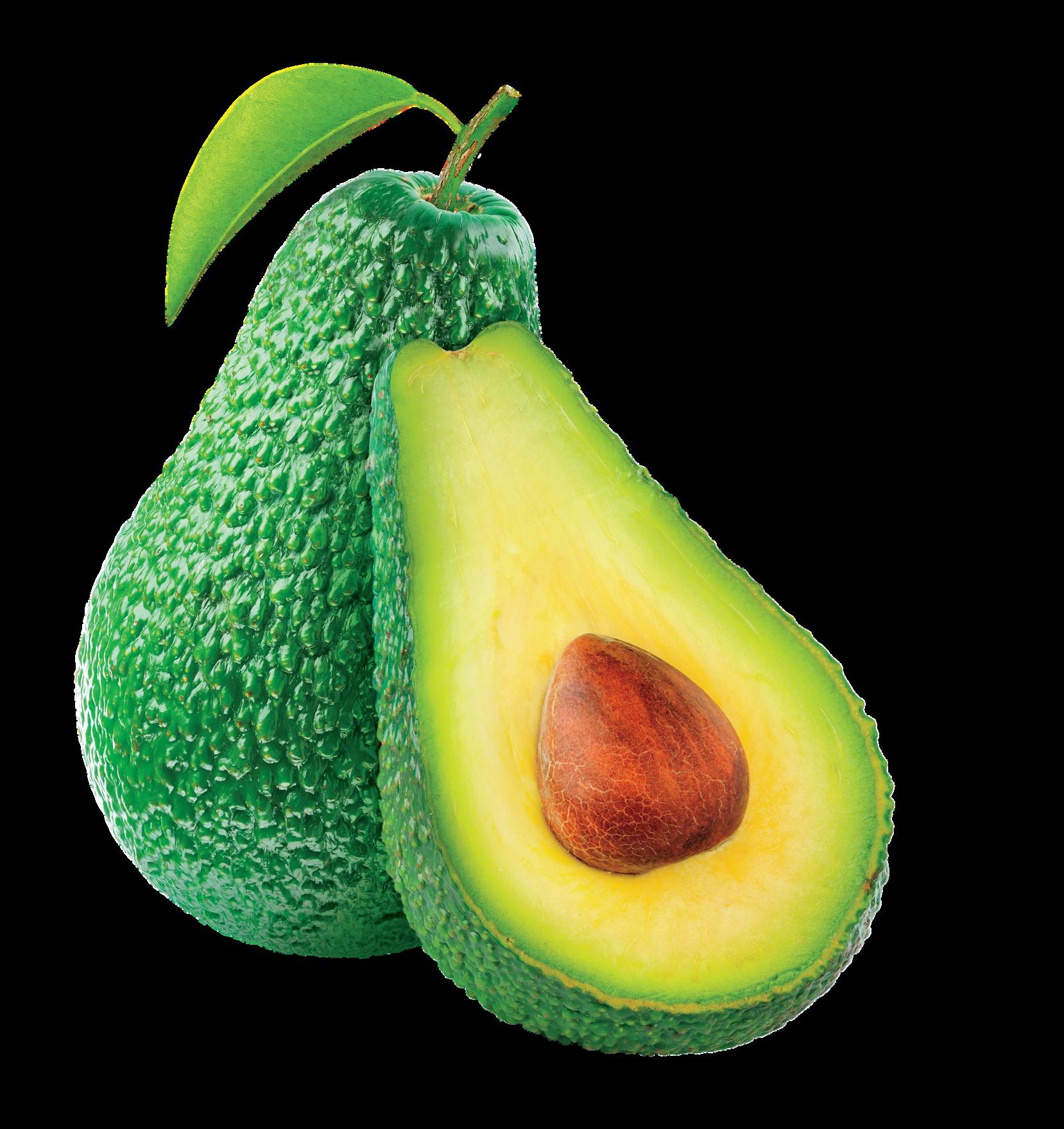
Did you know you may safely puree avocado to make homemade baby food? Check out this recipe for homemade baby food using avocados!
Ingredients:
• 1/4 avocado • 1-2 tsp. breastmilk or formula or water
Instructions
1. Wash hands and clean and sanitize all food preparation surfaces, including equipment (ie. knife and cutting board)
3. Rinse avocado under clean, cool water and scrub the skin with your hands or a vegetable brush.
4. Cut the avocado into quarters
5. Remove quarter from the skin using a spoon, place in bowl and smash with a fork until you reach smooth texture.
6. Serve immediately to baby. Discard uneaten puree within two hours.
This article was published by Michigan State University Extension. For more information, visit extension.msu.edu.
To have a digest of information delivered straight to your email inbox, visit extension.msu.edu/newsletters.

To contact an expert in your area, visit extension.msu.edu/ experts, or call 888-MSUE4MI (888-678-3464).
— Optional, add liquid (water, breastmilk or formula), starting with one teaspoon until desired consistency. — For a smoother texture, you may push the puree through a sieve or small mesh strainer.
54

Hospital's Mental
Awareness and
Trained Today at
-
Amy Busch
WhyImTrained
I'm trained because I want to feel more confident to reach out with hope and with resources if I talk to someone who is in crisis. I don't want anyone to feel alone.
Chelsea
Health
Training Program can help anyone get trained. Get
chelseahospital.org/mhat
As football season kicks off, let the tailgating begin!
Written by 5 Healthy Towns Foundation staff
Tailgating at any football game is a fun time. Connecting with friends and family in the crisp fall weather, enjoying one of Americas great pastimes with an assortment of food and snacks – what could be better than that?

More often than not the food shared at a tailgate isn’t exactly healthy or nutritious, but it doesn’t have to be that way. There are plenty of recipes out there that taste delicious and won’t leave you with the “day after” guilt.
Here are some recipe ideas to get you started:
B U F F A L O C H I C K E N Meatballs
Ingredients:
2 tsp olive or avocado oil
¼ cup minced carrots
¼ cup minced celery
¼ cup minced yellow onion
3 garlic cloves, minced or pressed
1 lb 90-93% ground chicken or turkey
¼ cup almond flour or flour of choice
¾ cup + 2Tbsp Buffalo Sauce, divided
Ranch for drizzling

Green onion and/or cilantro garnish
Directions:
Preheat oven to 375
In a non-stick skillet on medium-high heat, add oil, celery, carrots, onion, and garlic Sautee until onions are translucent, and vegetables are cooked through Remove from the skillet and let cool slightly
Next combine the chicken, flour, 2 Tbsp buffalo sauce, and sauteed veggies
Form into 16-20 golf ball sized meatballs The meat will be sticky but dampening hands with a little water will help to prevent the meat from sticking
Bake in preheated oven for 14-18 minutes or until meatballs ae cooked through and insides are no longer pink Flip meatballs after about 10 minutes of baking Total baking time will depend on the size of the meatballs

Return the meatballs to the skillet over medium high heat and add ¾ cup of buffalo sauce (or more if you like)
Gently toss and allow to simmer for 2-3 minutes
1 2 3 4 5 6
56
GREEK SALAD
Pinwheels
Ingredients:
2 large tortillas, any flavor
½ cup hummus
1/3 cup crumbled feta
¼ cup chopped tomato
¼ cup chopped pitted Kalamata olives
2 cups fresh baby spinach
Directions:
Lay the tortillas out on a cutting board. Spread hummus evenly over each one. Divide the feta, tomato, olives and spinach between the tortillas. Use your hand to flatten the fillings, then tightly roll up the tortillas. Place them seam-side down on the cutting board or a plate. Chill the rolls in the fridge for at least 30 minutes. You can wrap in plastic wrap or leave uncovered.
Remove the wraps from fridge and cut each roll into about 8 pieces. Arrange on a plate and serve.


JALEPENO CHEDDAR
Sweet Potato puffs
Ingredients:
1 ½ cups cooked mashed sweet potato
2 large eggs
¾ cup sharp cheddar cheese
3 Tbsp. plain Greek yogurt
2-3 strips of lean bacon cooked and chopped
1-2 jalapenos minced
Salt and pepper to taste
Directions:
Combine all ingredients in a bowl.
Scoop batter into greased mini muffin tins, about ½ full. Bake at 400 degrees for 20-25 minute

3 I N G R E D I E N T Peanut Butter Dip
Ingredients:
Greek yogurt
Peanut butter -smooth or crunchy, your choice
Honey to taste
Directions:
1 2





Place all of the ingredients in a bowl and stir until smooth and creamy
This dip is delicious with apple slices and bananas Use your imagination
 1. 2.
3.
4.
1. 2. 3.
1. 2.
3.
4.
1. 2. 3.
57
Access to Foods that Support Healthy Dietary Patterns
Increasing access to healthy, safe, and affordable food can improve nutrition and health across a person's lifespan.
Availability. The location, number, variety, and quality of grocery stores, food services, and farmers markets affects the availability of healthy foods in a community.

Cost. The cost of foods affects which items people can afford or choose to buy. The availability of produce and other healthier items can be limited and often more expensive at convenience stores and small food markets.
Transportation. Access to reliable transportation can make it easier to travel to food and gives people more choice in where they get food. Less access to reliable transportation can be a challenge for people living in rural or remote communities.
Community Programs. Local participation in community food support programs can help reduce prices and encourage healthier food choices, such as farmers markets that accept payment using Supplemental Nutrition Assistance Program (SNAP) benefits.
More information on this topic can be found in the Access to Foods that Support Healthy Dietary Patterns literature summary on health.gov.

58
Healthy for Good
HOW TO CONTROL CHOLESTEROL
UNDERSTAND CHOLESTEROL
Cholesterol is a fat-like substance that comes from two sources: FOOD and your BODY.
It is found in foods from animal sources only. It travels in the body by lipoproteins (LDL and HDL).
HDL = GOOD
High-density lipoprotein is known as “good” cholesterol.
LDL = BAD
Low-density lipoprotein is known as “bad” cholesterol.

TIPS FOR SUCCESS
EAT SMART
Eat a healthy diet of vegetables, fruits, whole grains, beans, legumes, nuts, plant-based proteins, lean animal proteins like fish and seafood. Limit sugary foods and drinks, red or processed meats, salty foods, refined carbohydrates and highly processed foods.
HDL helps keep LDL from sticking to artery walls and reduces plaque buildup. This process can lower the risk of heart disease and stroke. heart.org/cholesterol
TRIGLYCERIDES
The most common type of fat in the body.
TOTAL CHOLESTEROL
HDL level + LDL level + 1/5th of triglyceride level = total cholesterol level.
TRACK LEVELS
A health care professional can measure your blood cholesterol and help you understand what the levels mean in context of your overall heart health..
Track your cholesterol levels over time and take steps to reduce high cholesterol.
Check your heart disease risk with the Check. Change. Control. Calculator
MOVE MORE
Physical activity helps improve cholesterol levels.
KNOW YOUR FATS
The fats you eat can affect your cholesterol levels. Replace saturated fats with unsaturated fats.
NO NICOTINE
Smoking lowers good HDL cholesterol. It also raises your risk of heart disease.
TAKE MEDICATION AS DIRECTED
Your health care professional may prescribe statins or other medications to control your cholesterol levels.
59
Learn more at heart.org/lifes8 © 2022 American Heart Association, Inc., a 501(c)(3) not-for-profit. All rights reserved. Unauthorized use prohibited. Citations available upon request. 7/22 DS19388
TM American Heart Association®
LOCAL RESOURCES
ONEBIGCONNECTION.ORG
Are you looking for local resources in our 5 Healthy Towns area that can assist with Basic Needs, Housing and Transportation, LifeLong Learning, Natural World, Physical Activity, or Social Support opportunities? Visit onebigconnection.org/obc-local-resources to learn more about these partners and local resources.
The Resource Directory allows local non-profit service providers to post their own information and events at no cost to the organization. To learn more email matt@5healthytowns.org
100 Women Who Care – Chelsea Area

5 Healthy Towns Foundation

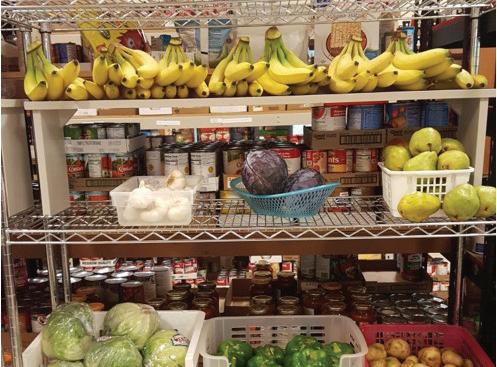
Adrian Veterans Administration Clinic
Adult Learners Institute of Chelsea
Arbor Hospice
Beckwith Preserve – Stockbridge
Big Red Barrel – Chelsea
Big Red Barrel – Dexter
Big Red Barrel – Grass Lake
Big Red Barrel – Manchester
Big Red Barrel – Unadilla Township

Cancer Support Community of Greater Ann Arbor
Carr Park – Manchester
Celebrate Recovery – Community Crossroads
Church, Stockbridge
Chelsea Area Historical Society
Chelsea Community Forum
Chelsea Community Foundation
Chelsea Farmers Market
Chelsea Friends and Family Wellness Coalition
Chelsea Hospital
• Diabetes Education and Prevention Program
• Neuropsychology
• Nutrition Consultants and Education
• Outpatient Behavioral Services
• Sleep Disorder Center
• Volunteers
Chelsea Retirement Community
Chelsea Senior Center
60 Check 5healthytowns.org and follow 5HF on Facebook
Chelsea Wellness Center
ChelseaCare Home Medical Equipment
Chi-Bro Park – Manchester
College Access and Career Center
Dexter Forum
Dexter Senior Center
Dexter Wellness Center
Dexter Wellness Coalition
Dexter Winter Farmers Market
Eddy Discovery Center
Faith in Action Chelsea/Dexter
Grass Lake Community Events Park
Grass Lake Community Wellness Initiative
Grass Lake County Park
Grass Lake Education Foundation

Grass Lake Farmers Market
Grass Lake Road Runners
Grass Lake Senior Center
Grass Lake Township Sports and Trails Park
Grass Lake Whistlestop Depot and Park
Henry Ford Orthopedics – Chelsea
Henry Ford Same-Day Care – Chelsea
Housing Bureau for Seniors
Huron Valley Area Intergroup (Addiction support groups)
Jackson County 12-step programs
Jackson County Health Department
Jackson District Library
Jackson District Library – Grass Lake Branch
Jackson District Library – Henrietta Branch
Jackson Veterans Administration Clinic
Kirk Park – Manchester
Manchester American Legion Auxiliary Unit 117
Manchester Area Historical Society
Manchester Community Resource Center
Manchester Community Schools
Manchester Lions Club
Manchester Masonic Lodge #148
Manchester Michigan T.O.P.S.
Manchester United Methodist Church
Manchester Wellness Center
Manchester Wellness Coalition
Mental Health Awareness and Training (MHAT)
MSU Extension
Mike Levine Lakelands Trail State Park
Mill Creek Park – Dexter
Mindful Dexter
Monitor Base Ball Club of Chelsea
Moodlifters
Munith Community Park
National Kidney Foundation of Michigan

Next Steps Recreation
Open Air Market of Stockbridge
Pierce Park – Chelsea
Pinckney State Recreation Area
Potawatomi Mountain Bike Association
Program to Educate All Cyclists (PEAC)
Rotary Club of Dexter
SRSLY Chelsea
SRSLY Dexter
SRSLY Manchester
SRSLY Stockbridge
St. Louis Center
Stockbridge Area Educational Foundation
Stockbridge Area Senior Center
Stockbridge Area Wellness Coalition
Stockbridge Community Education
Stockbridge Community Outreach
Stockbridge Lions Club
Stockbridge Wellness Center
The Cedars of Dexter
The Copper Nail
The Pines Senior Apartments – Chelsea
Timber Creek Counseling
Timbertown Park – Chelsea
Veterans Administration Ann Arbor
Healthcare System
Veterans Memorial Park – Chelsea
Veterans Memorial Park – Stockbridge
Washtenaw County Office of Community and Economic Development
Waterloo Recreation Area
Webster Township Historical Society
Wellwise Services Area Agency on Aging
Western-Washtenaw Area Value Express
(W.A.V.E)
Worth Repeating – Manchester
Wurster Park
61










































62 Brought to you by the 2019 - 2026 Washtenaw County Public Safety and Mental Health Preservation Millage washtenaw.org/millage CALL FOR MENTAL HEALTH OR SUBSTANCE USE SUPPORT 734-544-3050 For seeing the Big Picture We’re looking at where each of our institutions fit in the system. The millage supports collaborations that help us understand the roles we play in community mental health. THANK YOU WASHTENAW COUNTY REILEY CURRAN
HEALTH IMPROVEMENT
24/7
COMMUNITY
MANAGER, CHELSEA HOSPITAL

6363 Request an appointment: TrinityHealthMI.org/Spine 833-488-2225 Ease your back pain. Our Spine Program customizes a personalized treatment plan tailored to your specific needs. Start your journey today! • Physical Therapy • Pain Management & Rehabilitation • Medication and Injection Options
Surgical Intervention
•
harvesting success together


Embrace your community, support local farmers markets, and invest in local banking for a stronger, more sustainable future.
Explore the power of local banking & its positive impact on communities! Discover how Chelsea State Bank contributed to over 60 organizations last year, creating a ripple effect of economic growth. Join us in creating a positive economic impact together.
64
Member FDIC chelseastate.bank
Photo Credit: Nina Herrst Photography







































































































 million Americans have diabetes, and 1 in 5 don’t know it.
million Americans have diabetes, and 1 in 5 don’t know it.






































 Written by Alex Duranczyk
Written by Alex Duranczyk



























































































 5 Healthy Towns Foundation staff
5 Healthy Towns Foundation staff


































 1. 2.
3.
4.
1. 2. 3.
1. 2.
3.
4.
1. 2. 3.





















































